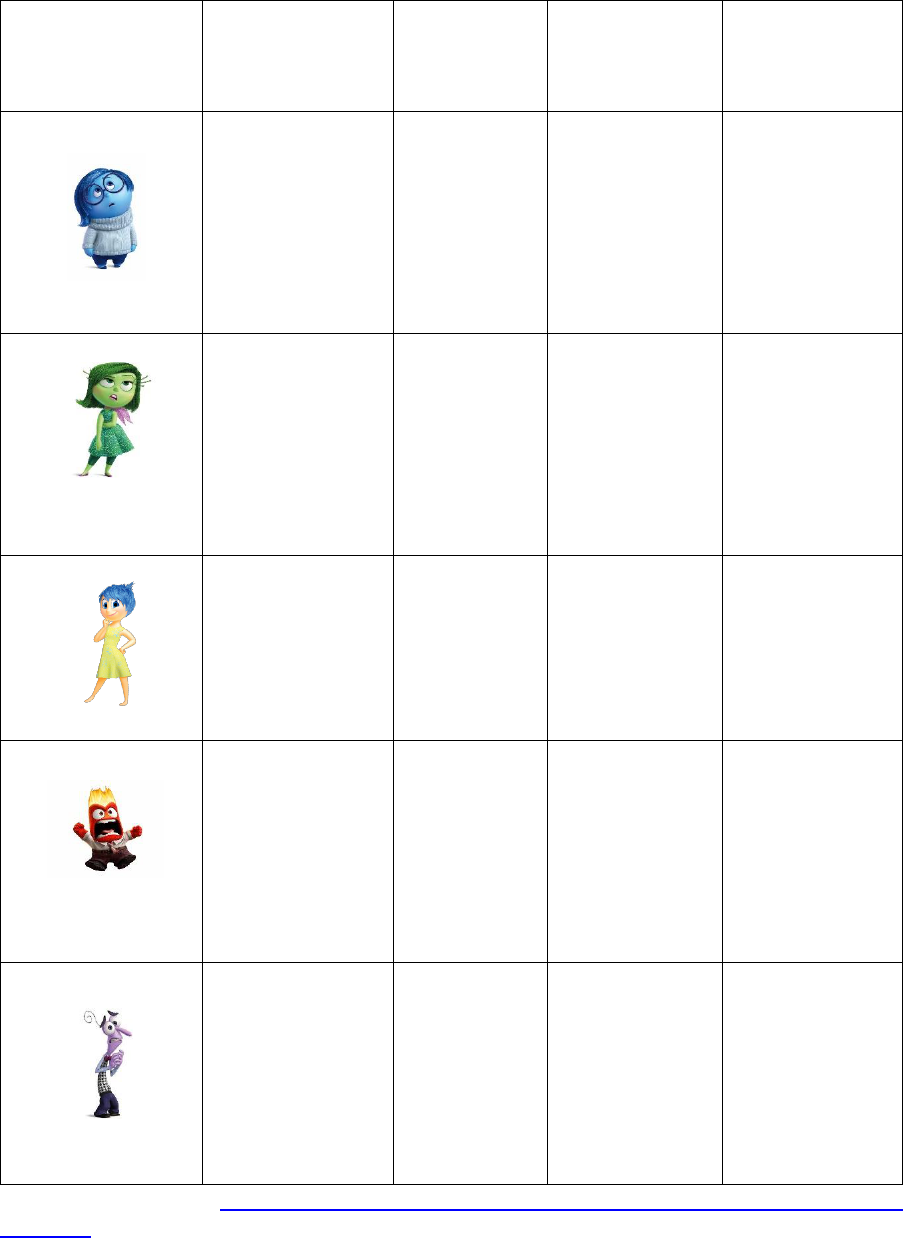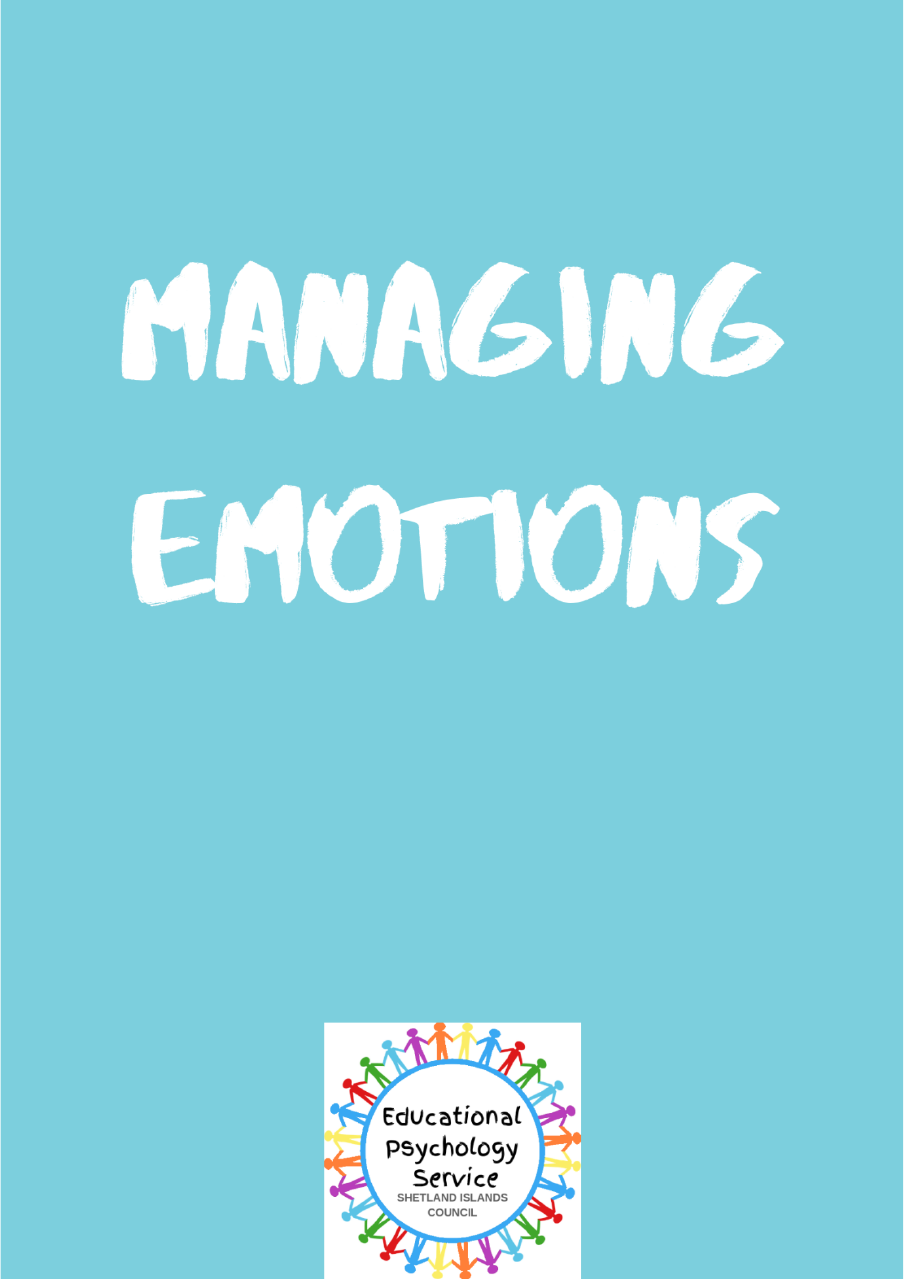

2
Contents
Introduction…………………………………………………………………………………….Page 4
Section 1: Talking to your Child about Feelings
Talking to Children about Feelings…………………..………………………...…………….Page 4
Inside Out: The Movie…………………………………..…………………………………….Page 6
Design Your Own Inside Out Character……………………………………...……………..Page 8
How Do I Feel Today? Check In ....................................................................................Page 9
Section 2: Anger
Helping Your Child with Anger………………………………………………………...……Page 10
What is Anger? ............................................................................................................Page 13
Anger Thermometer………………………………..………………………………………..Page 15
Volcano in your Tummy…………………………..…………………………………………Page 16
My Anger Triggers…………………………………………………….……………………..Page 17
Understanding My Feelings…………………..……………………………………………..Page 18
5 Point Scale: Anger Check In..……………..………….…………………………………..Page 19
Ok and Not Ok Reponses…………………………………………………….……………..Page 21
What Might Help ………………………..……………………………………………………Page 23
At Home, At School…………..……………………………………………………………….Page 25
My Stages of Anger………………………………………………………………………….Page 26
Section 2: Anxiety
Helping Your Child with Anxiety…………………………………………………………….Page 28
What is Anxiety?.………………………………………………...…………………………..Page 31
The 5 Point Scale: Anxiety Check In………………......…………………………………..Page 32
My Top Five Worries……………………………………….………………………………..Page 33
Big Problems and Small Problems…………………………………………………..……..Page 34
Comic Strip Conversations………………………………………………………………….Page 35
Social Stories ……..…………………………..……………………………………………..Page 37
Tools
My Calming Sequence…………………...………………………………………………….Page 38
Lazy 8 Breathing…………………………..…………………………………………………Page 39

3
The Six Sides of Breathing…………………...……………………………………………..Page 40
Skill Cards…………………………………….………………………………………………Page 41
Appendix
Appendix A: Building Resilience ……………………………………..…………………….Page 44
Appendix B: Identifying Emotions in Others……………………………….………………Page 45
Appendix C: The Feeling of Anger…………………………………………..……………..Page 49
Appendix D: The Stress Scale……………………………………………...………………Page 51
Appendix E: The High Low Scale…………………………………………….…………….Page 52
Appendix F: Cut Out and Keep Scales………...…………………………………………..Page 54
Appendix G: Inside Out: Getting to Know my Emotions……………………..…………..Page 55
Appendix H: Inside Out Trace Emotions………………………………….……………….Page 56
Appendix I: Inside Out Feelings and Calm Down Worksheet………..………………….Page 57
Appendix J: My Worry Monster………………………………………..……………………Page 58
Appendix K: Talking About My Worries…………………………………..………………..Page 59
Useful Links……………………………………………..……………….……………………Page 60
References……………………………………………………………………………………Page 63

4
Introduction
This document is intended to provide information, strategies and tools to help you help
your child talk about their feelings and manage their emotions. It has been developed
by Shetland Islands Council Educational Psychology Service using a range of
materials and resources from a variety of sources. Resources are referred to
throughout the document and you will find a complete reference list at the end of the
document.
Section 1:Talking to your Child about Feelings
Talking to Children about Feelings
It is important to help children understand their feelings and why they might be feeling
certain ways. You can help your child understand their feelings by letting them know it
is good to talk about how we feel, you can model this by talking about your own feelings
in a child friendly and age appropriate way. It is important for children to understand
that all feelings are normal. It is how we cope with these feelings and how we behave
that really matters.
The following might be helpful when talking about feelings with children:
Let your child know that we all experience different feelings, all feelings are
normal at one time or another. There are no right/wrong or good/bad feelings.
Difficult feelings are usually a normal response to a particularly difficult or hard
situation or event.
Feeling worried, scared or angry are normal feelings that everyone has
sometimes. It is very common for especially for young children to have fears
and worries about things that seem to them scary and dangerous e.g. bumble
bees, spiders, clowns etc. Sometimes children worry about making new friends,
going to parties, doing school work or being away from their parents or home.
Some children might get angry when a classmate breaks their toy or a teacher
tells them off.
We can all learn ways of managing difficult feelings and learning to feel brave,
confident and calm even when difficult things happen.
A first step to helping your child manage their feelings is to talk about them and
give them an ‘emotional vocabulary’. This will help them talk about their feelings
and emotions, it will help them learn and identify their own feelings. This is the
first step to learning how to manage them.
Feelings can also change from minute to minute and day to day depending on
our situation and it is possible to experience different feelings at different times.
5
There are some great animated movies that can help children understand their
feelings and emotions including Angry Birds and Inside Out. You may want watch
these at home as a fun and safe way to learn and talk about feelings and emotions.
Several themed worksheets are included here for you to try with your child
(additional worksheets can be found in the Appendix).
An emotional check in worksheet is also included which can be done daily with your
child. This should give you insight into how your child is feeling each day and open
up discussion as to the reasons why and what can be done to help them.
The toolkit also provides various calming techniques and strategies that children may
find helpful when trying to calm down and de-escalate their feelings.
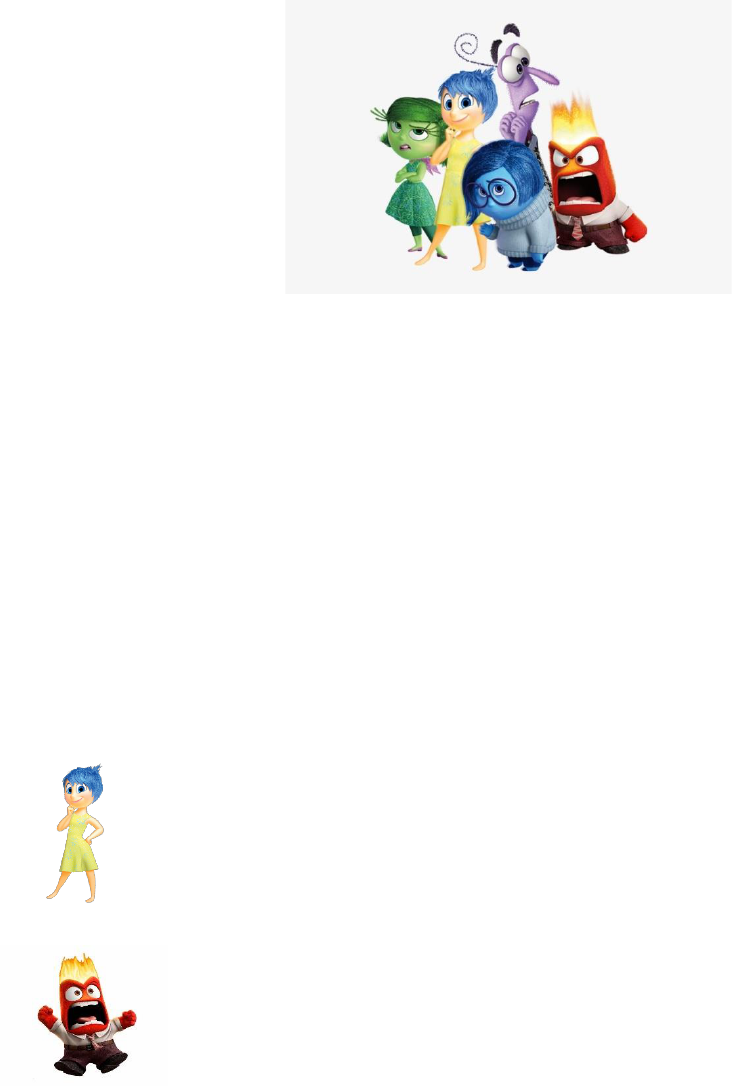
6
Inside Out – The Movie
Today I am feeling
Because_________________________________
________________________________________
________________________________________
________________________________________
________________________________________
________________________________________
I feel
When________________________________
_____________________________________
When_____________________________
__________________________________
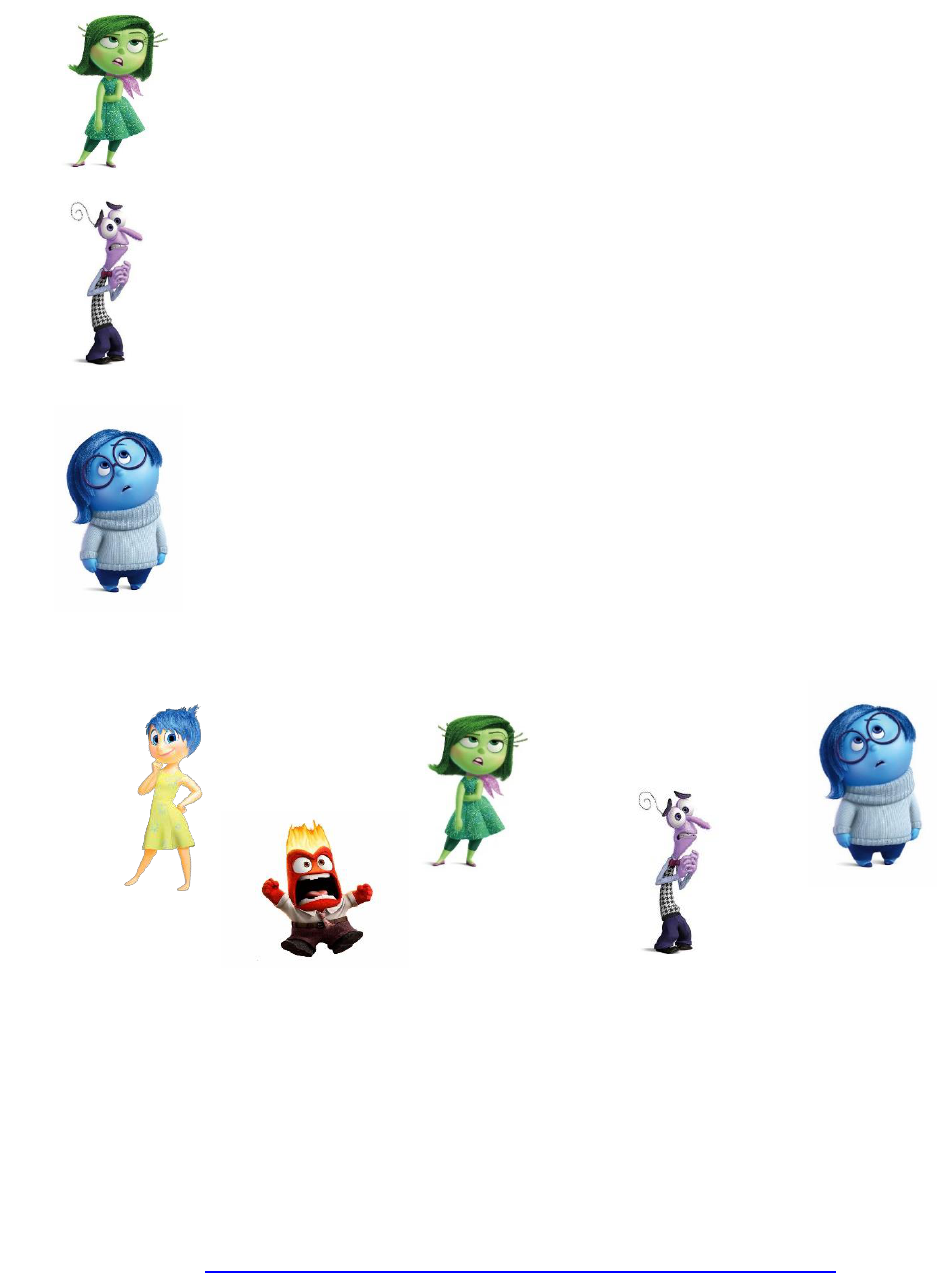
7
When_____________________________
__________________________________
When___________________________
________________________________
When_____________________________
__________________________________
Draw a time you felt either…..
Adapted from https://en.islcollective.com/english-esl-worksheets/search/Inside+Out
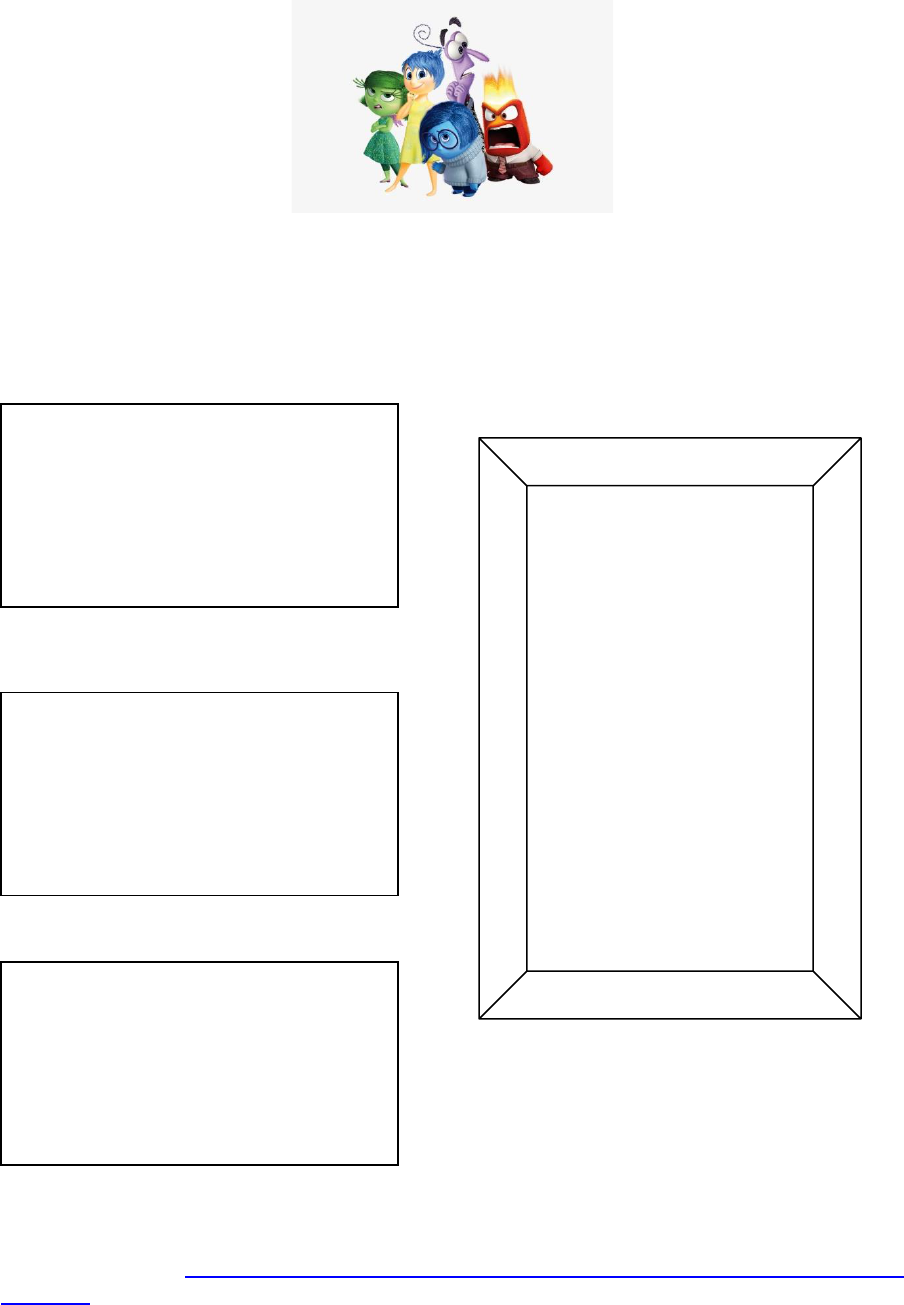
8
Design Your Own Inside Out Character
Emotion………………………………………………
Name………………………………………………….
Adapted from https://www.tes.com/teaching-resource/design-your-own-inside-out-character-
11759544
The colour is ______________________
I chose this because _________________
_________________________________
_________________________________
The shape is ______________________
I chose this because _________________
_________________________________
_________________________________
I chose this emotion because
_________________________________
_________________________________
_________________________________

9

10
Section 2: Anger
Helping your child with Anger
This section about helping your child with anger has been adapted from Hands On
Scotland accessible at: www.handsonscotland.co.uk.
Anger is a very common emotion that everyone experiences at times. If a child or
young person feels angry this is not a problem in itself. However, it is important that
children and young people learn to express their anger constructively.
If anger is ignored it can build up inside and may lead to them expressing it in
disruptive behaviour or turning their frustration on themselves and those around
them. Expressions of anger can range from mild irritation to full-blown rages, verbal
outbursts and physical violence.
Feeling angry at times is as natural as feeling happy or sad. However we often see
anger as a bad thing and we may even be scared of it, because of its occasional
explosive nature.
Children and young people experience anger for the same reasons that adults do,
for example, when they are stressed, frustrated, or feel that something is
unfair. They may have been annoyed by something that just happened and are
reacting to it immediately. They could also be feeling angry about things that
happened in the past, and may be carrying a lot of bottled up anger around with
them.
In trying to understand why a child or young person may be feeling angry, it is helpful
to think about specific situations that may be causing them stress, for example:
Are they struggling at school?
Are they being bullied?
Are there any issues at home?
Has there been significant change, loss or bereavement?
Are they unable to express themselves verbally? Anger can occur in children
or young people who have difficulty in expressing their views or feelings in
words.
Think about your response
Anger is something that we have all experienced at some time in our
lives. Everyone knows what it feels like to be angry or to experience someone else’s
anger, and your experiences will affect your response to a child or young person who
is angry. It is important to be aware of your own feelings and experiences so that you
can respond helpfully to the child or young person.

11
What you can do
When they are angry
Lead by example by remaining calm.
When calming them down, be assertive but do not shout or lose your own
temper. Instead, show them that you can handle their angry feelings without
becoming aggressive yourself.
Reassure them that you understand how they are feeling.
Explain the situation to them. A child or young person may be feeling angry
because they are feeling a lack of control, ignored or disrespected.
Offer them choices, time and space to try to defuse and de-escalate the
situation. This can be as simple as, "I wonder if it would help if we come back
to this in a minute?’ or ‘We can come back to this later when we are feeling
better’. "Do you want to get some air and come back to this in a few
minutes?" Continuing with demands at this point is likely to lead to an
escalation in behaviour so where possible reduce demands and offer
preferred choices to calm down. Offering a favourite activity can help distract
and calm a child down.
Sometimes using humour can help distract and calm the child or young
person, but be careful not to embarrass them or make them feel that you are
not taking them seriously.
It can be more difficult for them to back down if they fear losing the respect of
friends. If they are not calming down, de-escalate by calmly encouraging them
to go somewhere private/use a safe space or ask others to give you space so
you can be with your child.
If the child or young person is very angry and has lost their temper or is being
aggressive, it may be necessary to remove them or others from the situation.
This should always be done with the child or young person's safety in mind,
as well as your own.
When they are calm

12
Explain to the child or young person that anger is a normal emotion and
everybody feels angry at times.
Encourage them to talk about their feelings and help them explore their anger
so that you can both try to understand what’s making them angry. This can
help them feel less frustrated and also shows them that you understand.
Try to identify what triggers their anger. Once you have identified the triggers
and the reasons behind their anger, you can help them to develop different
ways of coping and dealing with these situations.
Help them to control their anger or express it in more positive ways. Praise
and encourage them to notice situations in which they have handled their
anger well or have expressed it effectively and calmly. This will build
confidence, reduce frustration and will make it more likely that they will repeat
the positive behaviour.
Talk to them about being respectfully assertive when they disagree with
someone else’s opinion or behaviour. Role-playing in different situations can
be a useful learning experience, and can be done one-to-one or with a group.
Give the child or young person other ways of reducing tension, for example
exercise or relaxation.
When in a difficult situation yourself, remember to stay calm and show them
that anger is manageable and can be dealt with.
What not to do
Don’t lose your own temper, as this shows the child or young person that this
behaviour is ok, and it prevents you from responding helpfully.
Don’t get into arguments, as the child or young person may become more
frustrated and angry if they're losing the argument.
Don’t make fun of them, as this is likely to make them feel humiliated and
more frustrated and angry.
Don’t use physical restraint, except to protect the child or young person or
others from serious harm
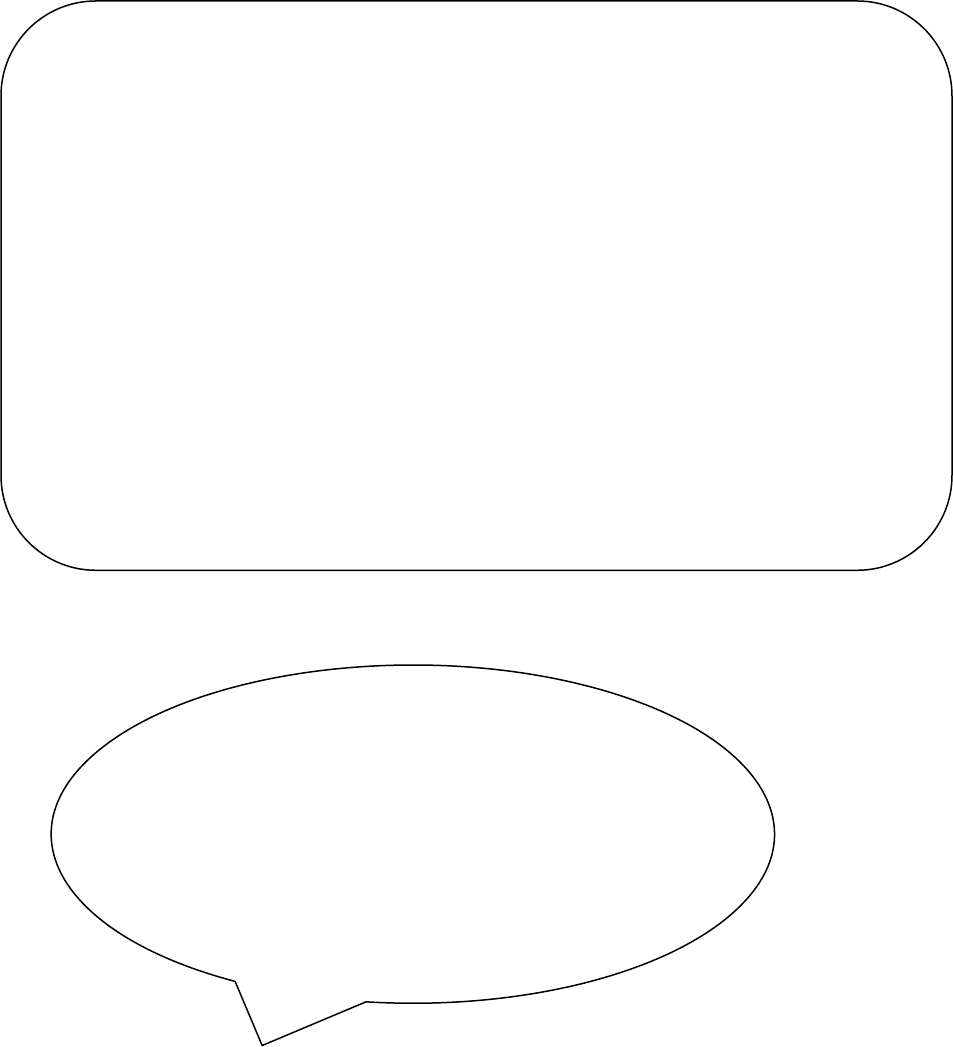
13
What is Anger?
Anger is a difficult feeling. When you’re angry you might do bad things that you
wouldn’t do if you were happy. But did you know that it’s normal to feel angry from
time to time? It happens to everyone.
Draw a picture of what you look like when you’re angry.
What is something you say when you are angry?
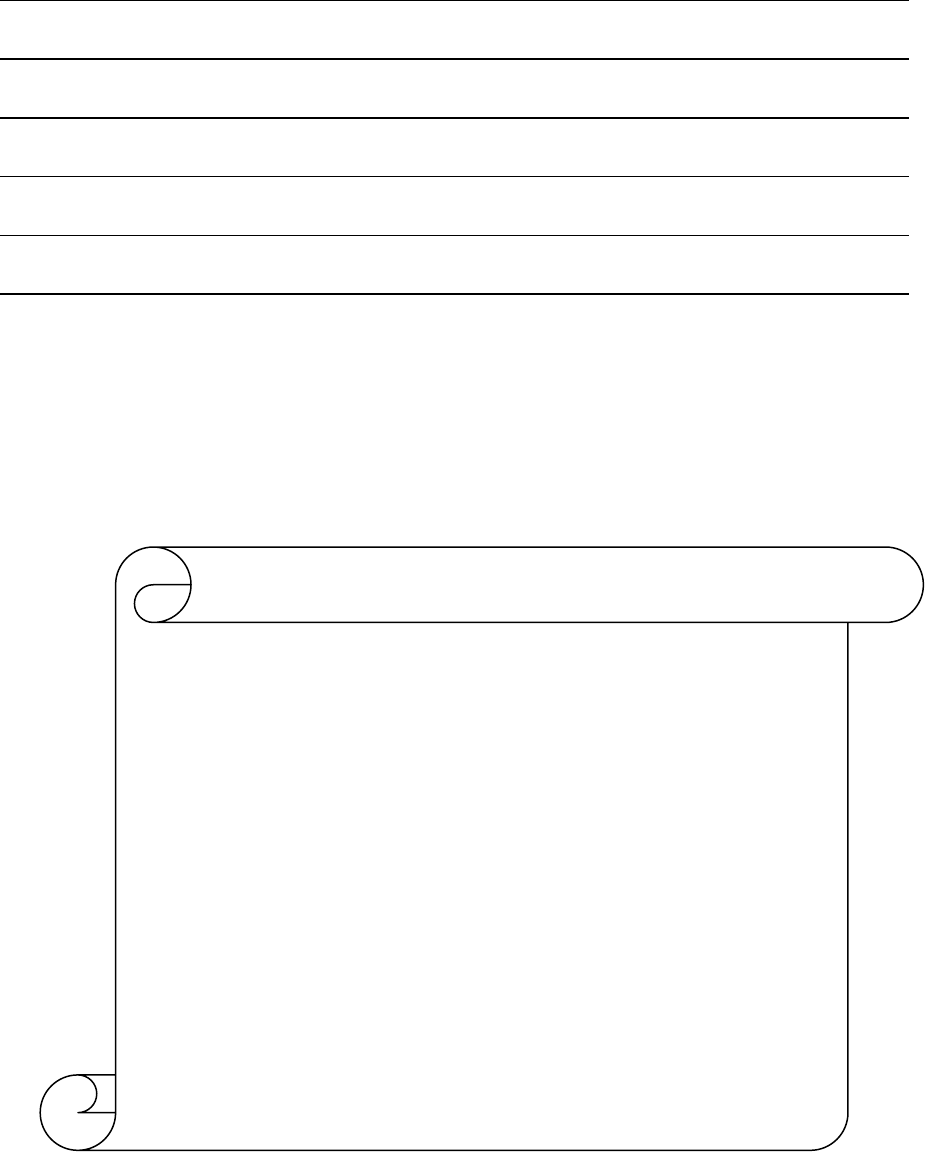
14
All sorts of things can make a person feel angry. Some people get mad when they
have to follow a rule they don’t like, or when another person is mean to them.
List some things that cause you to feel angry.
Even though it’s normal to feel angry from time to time, it’s never ok to be
mean, break things, hurt others or hurt yourself. Learning to control your
anger is about learning new ways to act when you’re upset.
Here’s a list of healthy things you can do when you feel angry. Circle the ones
that you might like to try.
Take deep breaths. Draw your anger.
Do jumping jacks. Write about your anger.
Count to 100. Walk away.
Talk to someone. Squeeze a stress ball.
Squeeze a stress ball. Play outside.
Listen to music. Practice a hobby.
Adapted from TherapistAid.com (2015)
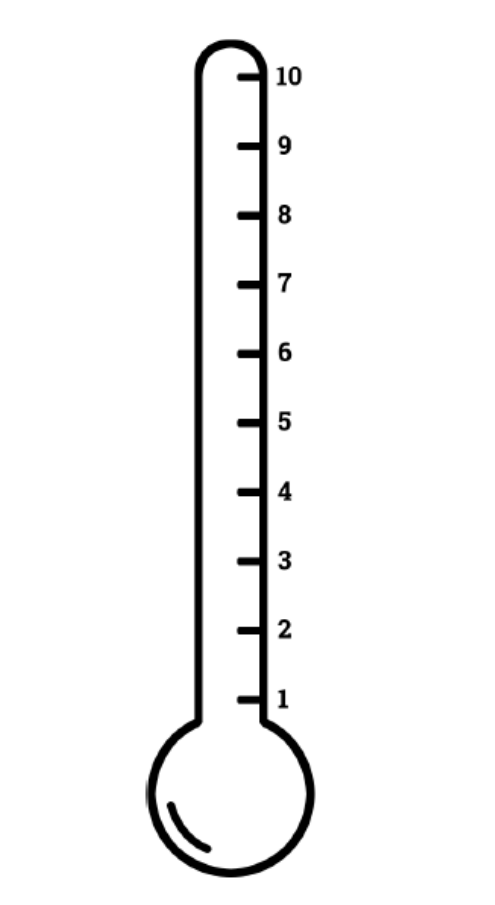
15
Anger Thermometer
Rank your experience with anger on a scale from 1 to 10. A ‘10’ should be the
angriest you can imagine and a ‘1’ should be completely calm. Include:
A short description of what happened
How you reacted
How you felt
What the consequences were.
Everyone experiences anger in different ways, so your scale might not be the same
as someone else’s.
Adapted from TherapistAid.com (2012)
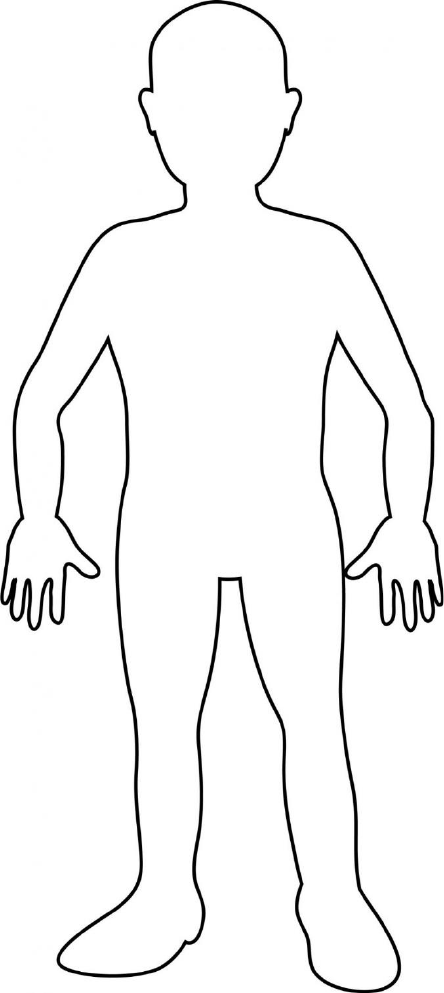
16
Volcano in your Tummy
Do you have a volcano in your tummy or explosions in your
head?
When we feel angry, things happen to our bodies. Draw what
happens to you and label your picture e.g. red face.
Adapted from Putney, W. & Whitehouse, E. (1998) A Volcano in my Tummy, New Society Publishers
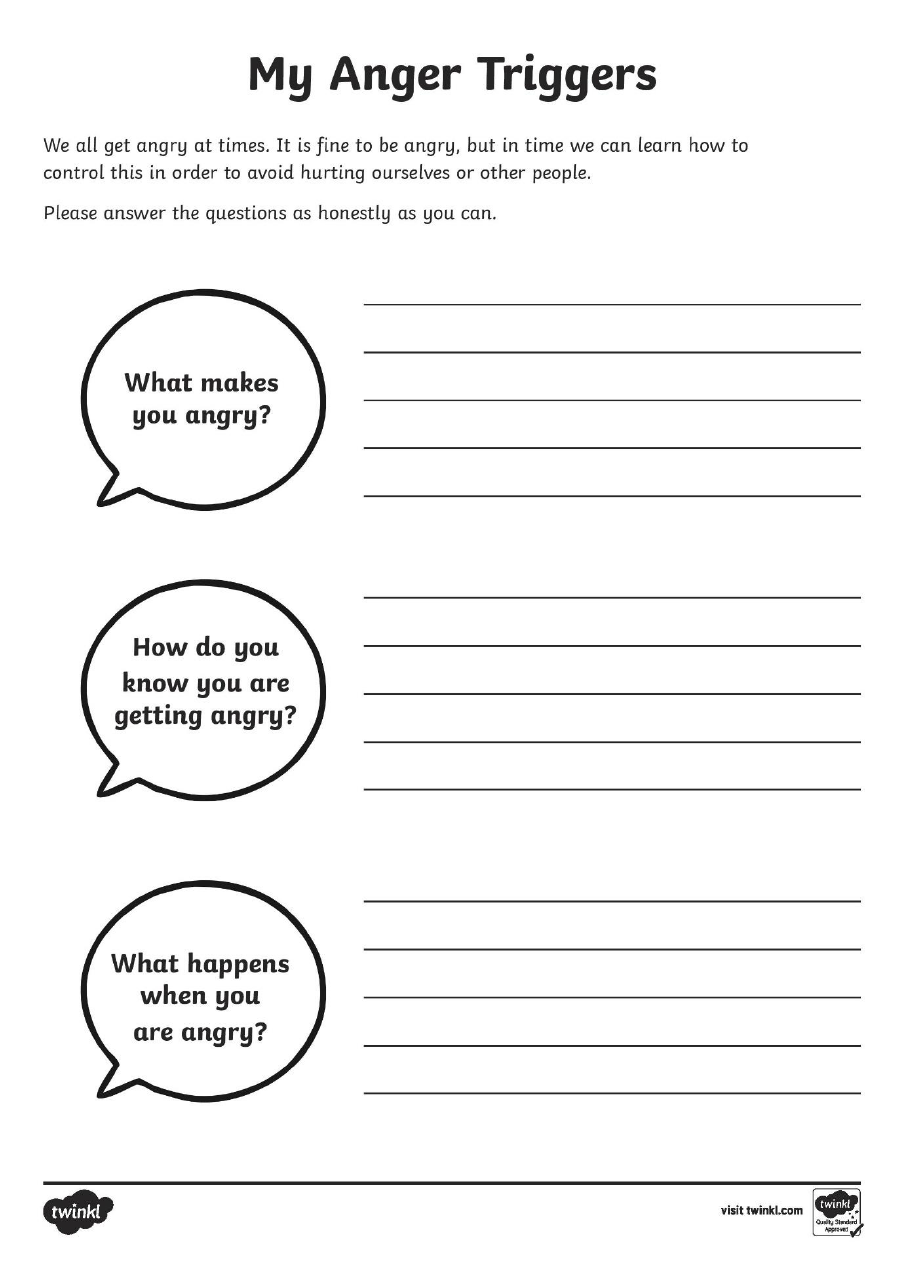
17

18
Understanding My Feelings
Can your child give their own examples in the right hand column. You could try this
with any feeling or emotion.
Feeling – Mad/Angry
Example
Your Turn
My word for this is:
Cheesed off
My word for this is:
This is how I look:
Frowning
This is how I look:
This is how my body
feels:
Like it’s over heating
This is how my body
feels:
This is what I do:
Throw stuff
This is what I do:
This is what I say:
GO AWAY!!
This is what I say:
19
5 Point Scale – Anger Check In
The 5 Point Scale is used to help children become more aware of their emotions,
such as anger, pain or worry. The scale helps children understand the level of the
emotion in stages.
Using this scale, speak through with your child their levels of anger and how this can
escalate. Keeping in mind the appropriate and non-appropriate responses. Giving a
number in relation to the level of an emotion instead of naming it helps children think
efficiently and make good decisions in a variety of situations.
Each number on the following page has a corresponding level of emotion e.g. 1 =
Happy, 2 = Irritated, 3 = Annoyed, 4 = Mad, 5 = Angry. Explain these levels of
emotion to your child so they understand and are able to communicate their feelings
to you using the numbers.
Throughout the day ask your child what level of anger they are feeling. This could be
done first thing in the morning, before going to bed or after completing a task. It may
be helpful to display this somewhere in your home so your child can easily access
this in order to communicate with you how they are feeling.
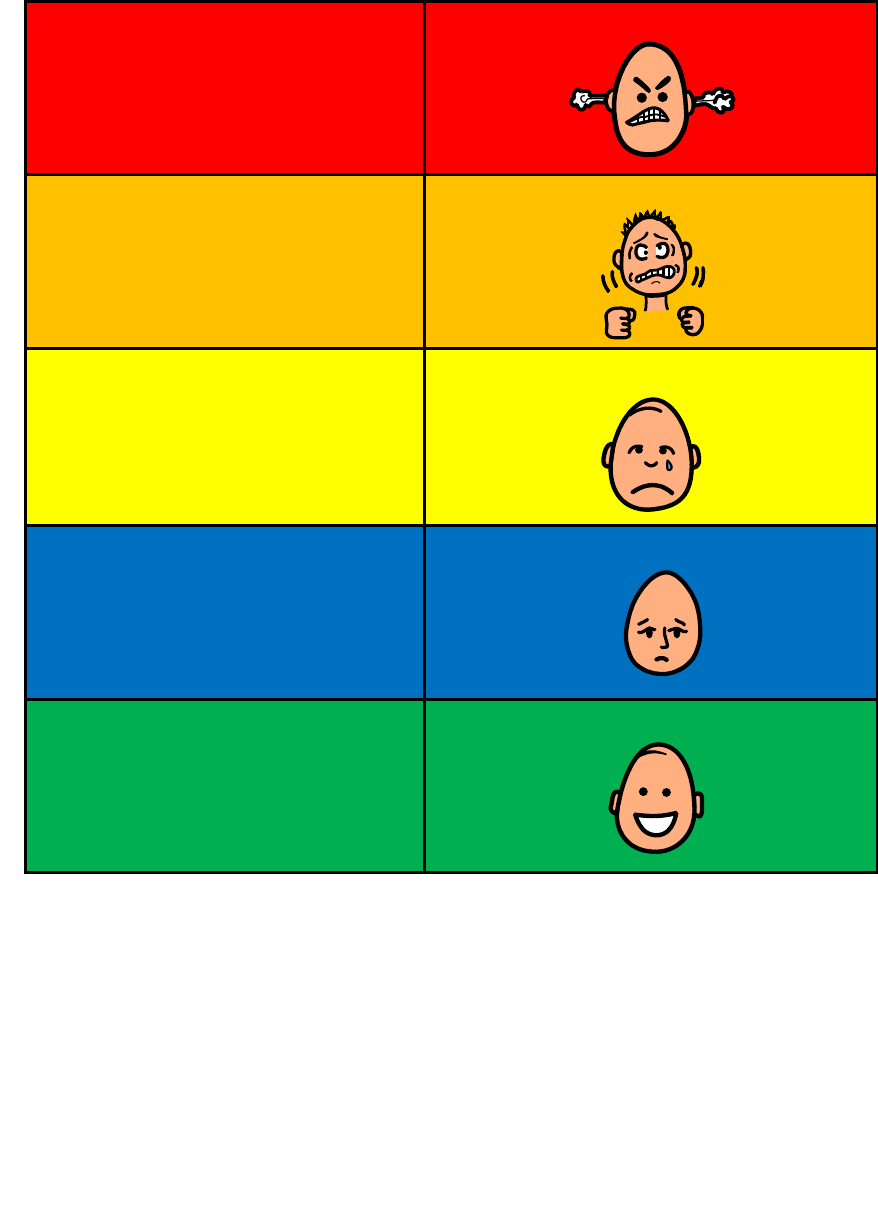
20
Anger Check In
Adapted from Coffin, A. B., & Smith, S. M. (2009). The Incredible 5-Point Scale (Columbus)
5
Angry
4
Mad
3
Annoyed
2
Irritated
1
happy
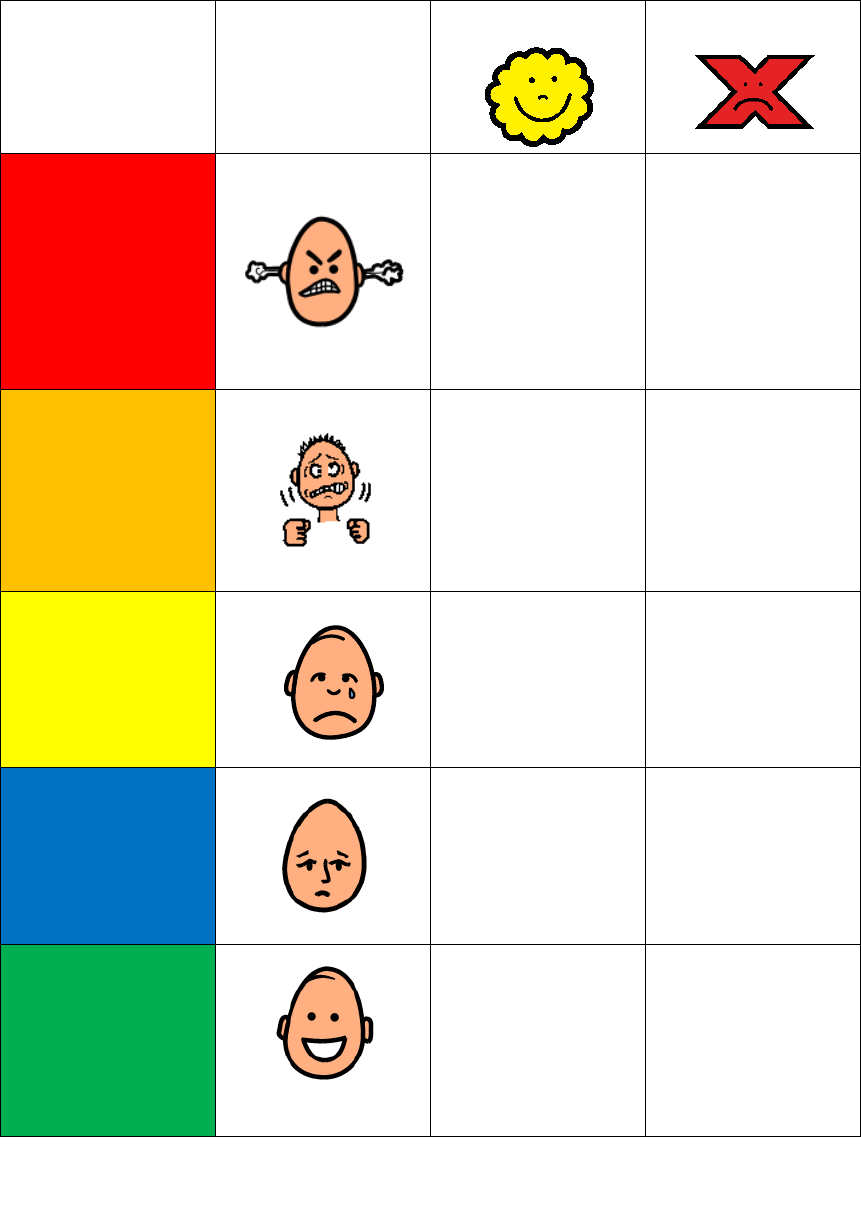
21
OK and not OK responses
Here is an example of an event which could cause anger and explains the ‘ok’ and
‘not ok’ responses to have. There is a worksheet for your child to try, with a real life
topic for them.
Topic: My brother broke my toy
Number
Feeling
OK
Not OK
5
Take a deep
breath
Run on the spot
Go to an adult
who can help
me calm down
Hitting
Shouting
Kicking
4
Take a deep
breath
Count to ten
Take myself to a
quiet spot
Shouting
Pushing
3
Take a deep
breath
Shouting
2
Tell an adult
Go get a toy
Shouting
1
Go to the next
space in the line
Think ‘it’s ok, I’ll
get a turn at first
another time’
Enjoy being in
the line with
everybody else!
Adapted from Coffin, A. B., & Smith, S. M. (2009). The Incredible 5-Point Scale (Columbus
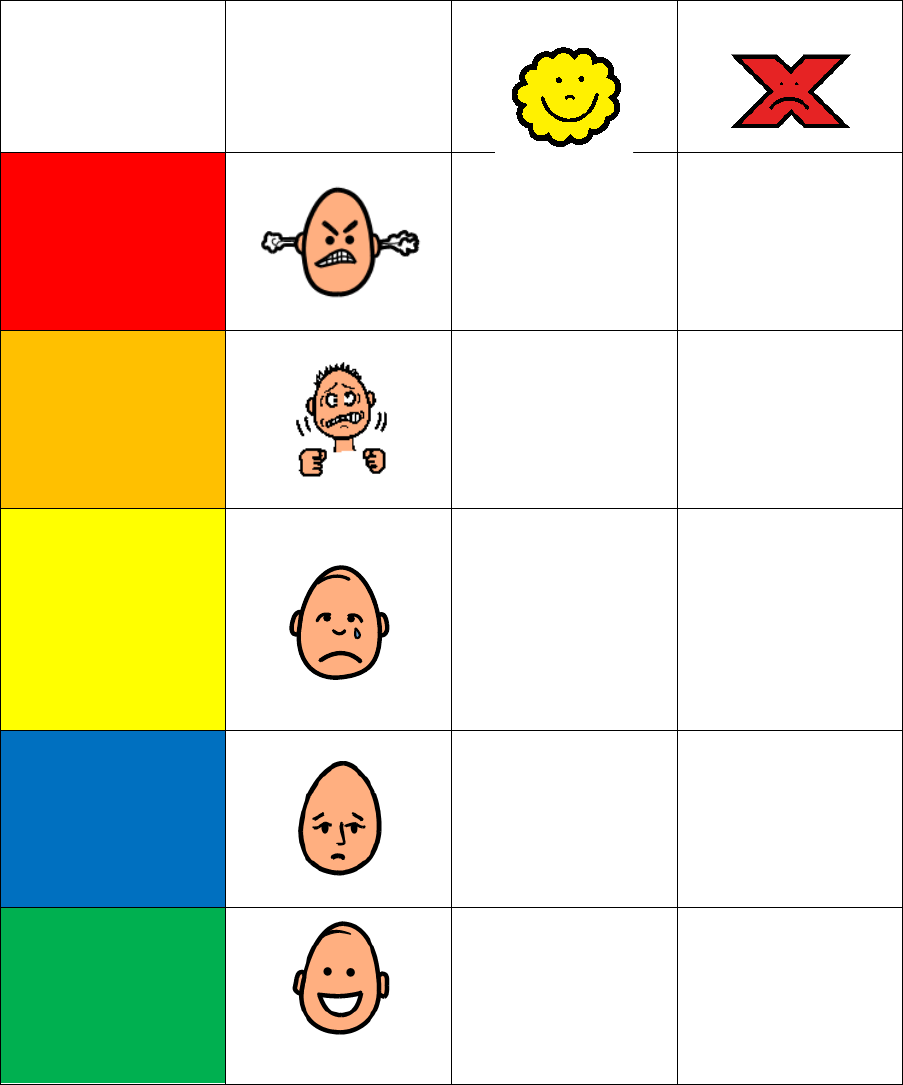
22
Your Turn…
Topic:
Number
Feeling
OK
Not OK
5
4
3
2
1
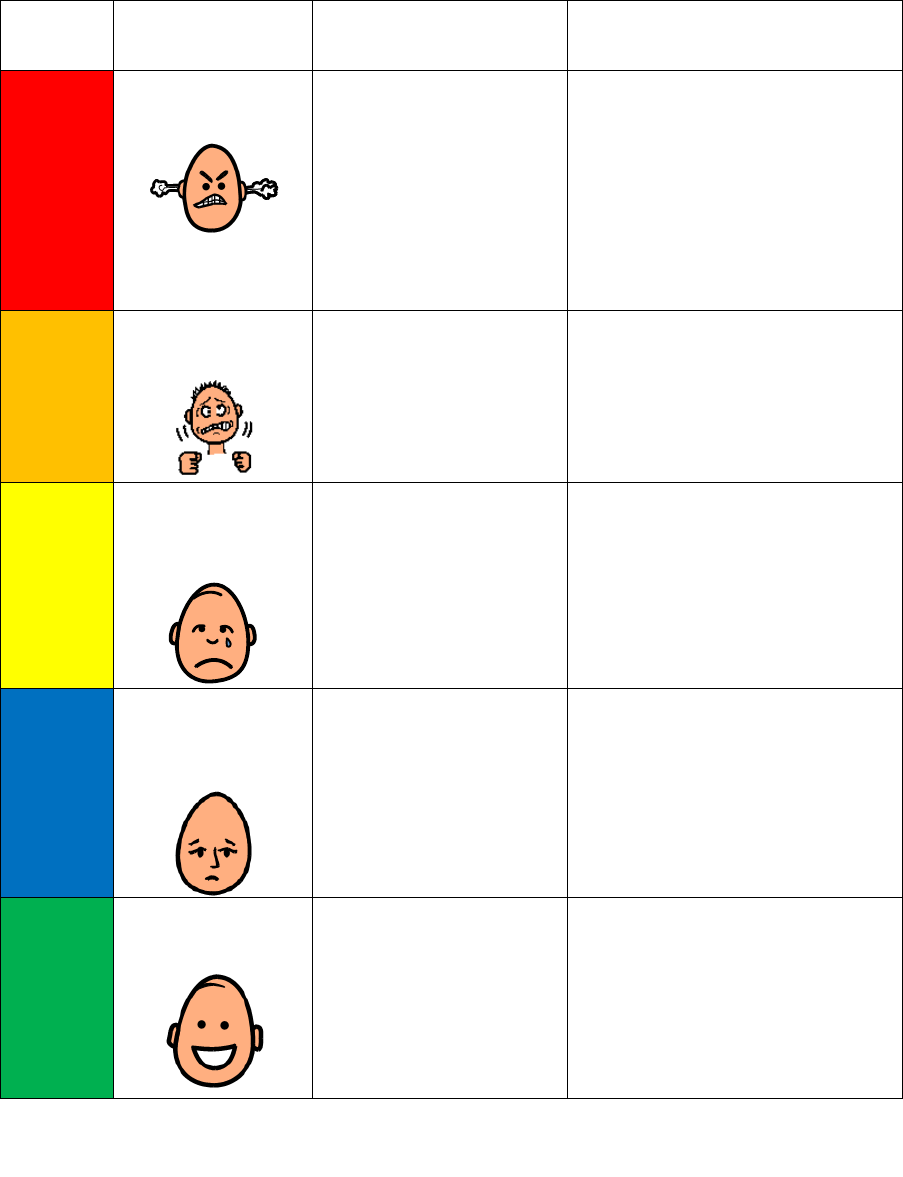
23
What might help
Here we explore examples of what might help children when their emotions are in
different levels.
Adapted from Coffin, A. B., & Smith, S. M. (2009). The Incredible 5-Point Scale (Columbus)
No.
Might be
called
Feels like
What might help
5
Big red hot
zone
I feel like someone
else
I feel like a different
person
Like trying to bully
someone
Like a red-hot chilli
Go straight to the quiet
place so I can start feeling
like a 4 then a 3then a 2.
Someone could help me go
to the quiet place if I forget
– I’ll know this is what we
agreed would be helpful.
4
Frustrated/
confused
I feel like kicking a
wall or smashing a
window, but don’t
actually do it
Try and calm myself down
by taking deep breaths.
Someone could say
‘Remember, go to the
quiet space.’
3
Worried/
Tired/ Bit angry
I feel like going to
bed to forget about
it, and get up when
it’s fixed
Someone could say
‘(Name) do you need a
break?’
Then I can go and sit down
for a while, then join back
in when I’m ready
2
Bit excited/
Not sure about
something
‘When is it going to
happen?’
‘I really want to go’
‘I’m all fired up’ (like
singing in choir on
Saturday)
Ask someone ‘What’s
going on?’
Say ‘I’m not sure what’s
going on here.’
Try and calm myself down
by taking deep breaths
1
Calm/ relaxed/
happy
When no-one’s
arguing
Watching TV
Playing on Wii (if it’s
working)
No help
needed!!!
JUST ENJOY!!!
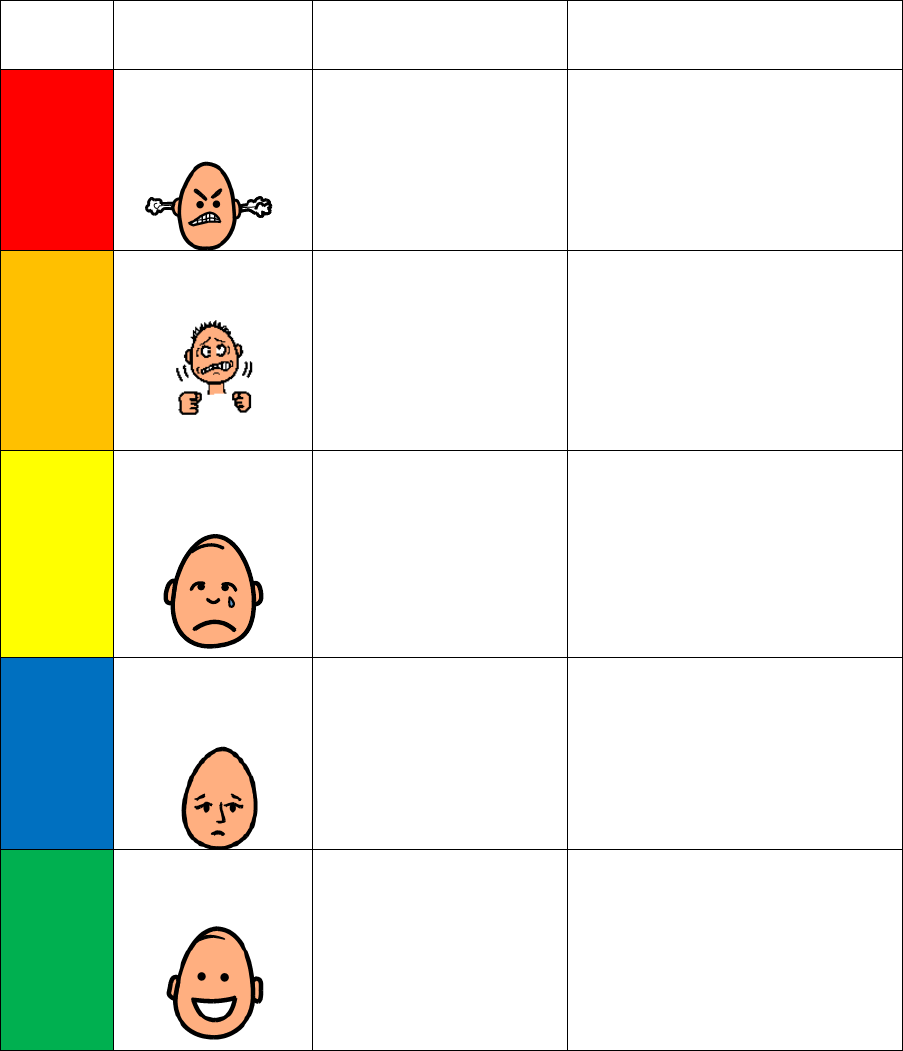
24
Your Turn…
Support your child to think of their own examples below.
No.
Might be
called
Feels like
What might help
5
-------------
4
--------------
3
---------------
2
---------------
1
---------------
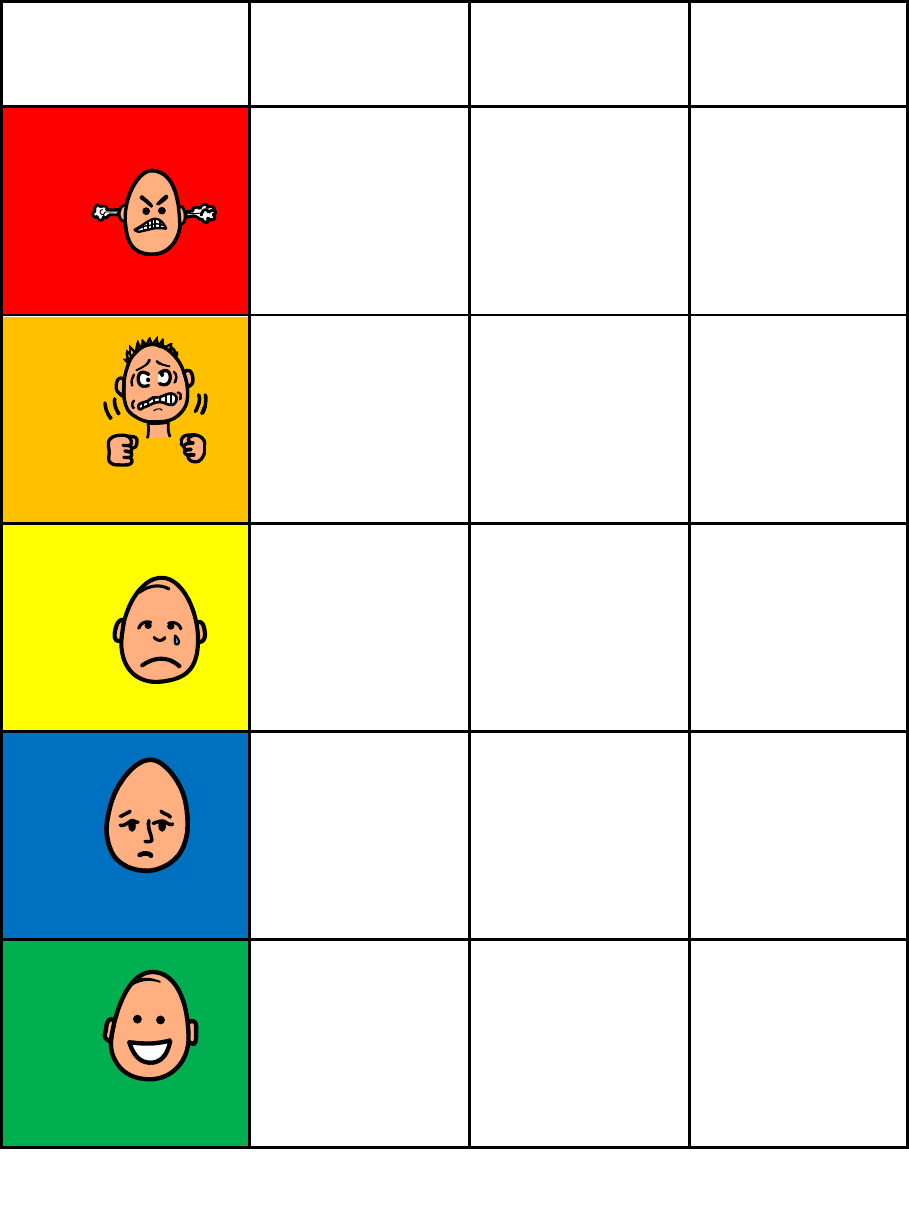
25
At Home, At School
Your child may like to highlight times when they have felt different levels of anger
either at home, or at school here.
Adapted from Coffin, A. B., & Smith, S. M. (2009). The Incredible 5-Point Scale (Columbus)
Example
Looks like/Feels
like
What I can try to
do
What can help
5
At home
At school
4
At home
At school
3
At home
At school
2
At home
At school
1
At home
At school
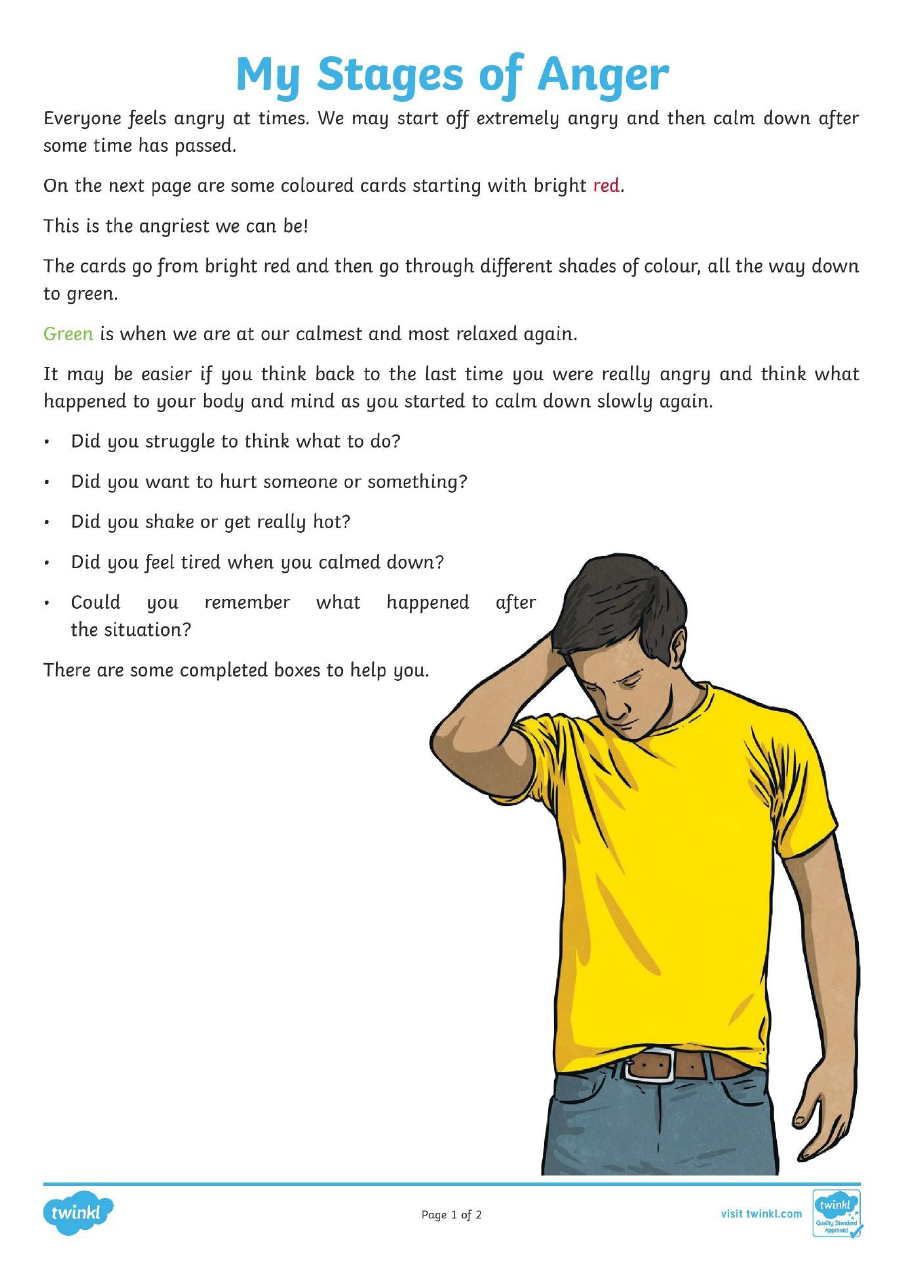
26
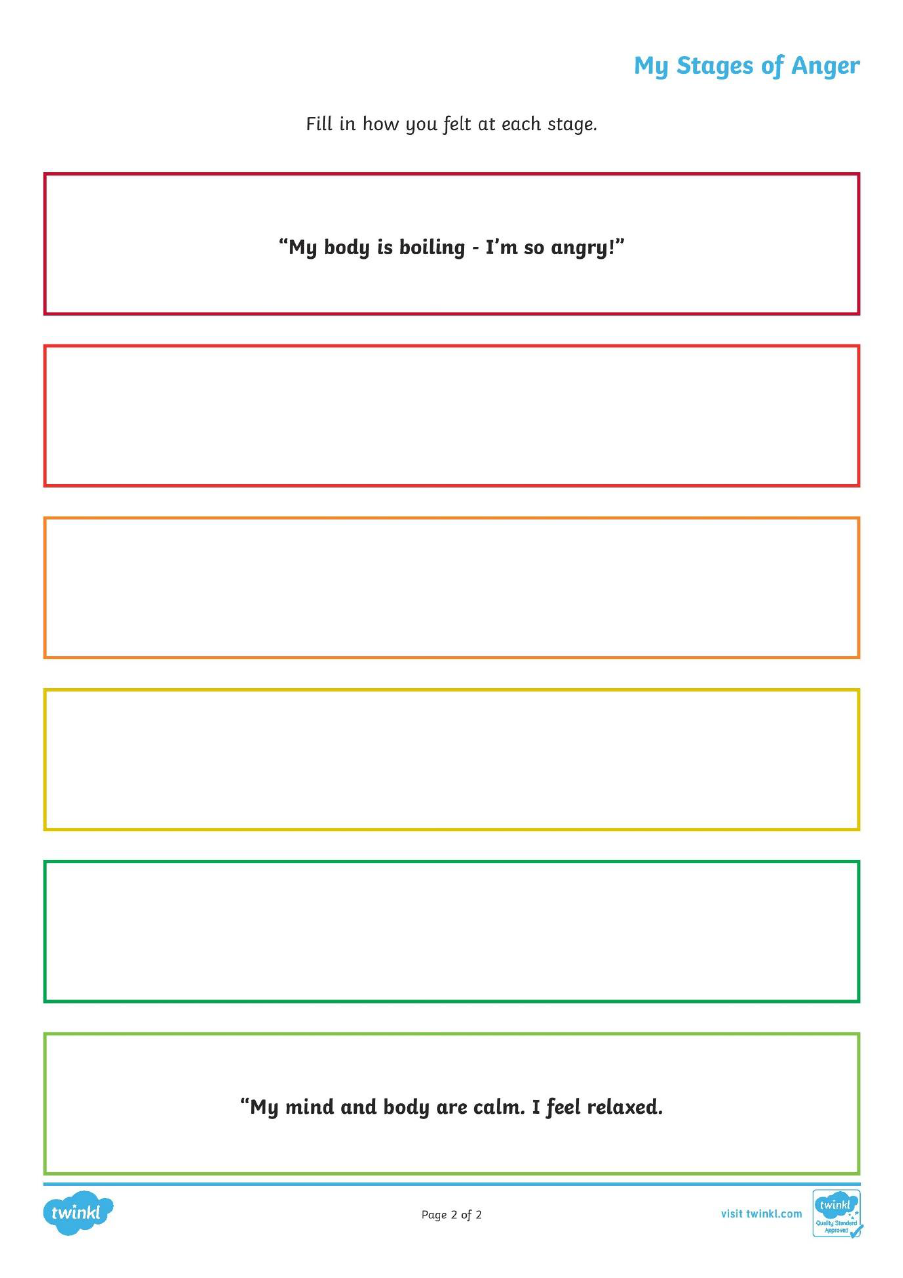
27

28
Section 2: Anxiety
Helping your child with Anxiety
This section about helping your child with anxiety has been adapted from Hands On
Scotland accessible at: http://www.handsonscotland.co.uk.
Everyone experiences anxiety from time to time. Anxiety is a term used to describe
the thoughts and feelings we get when we are frightened, worried or stressed.
Feeling anxious causes the body to produce adrenaline, which leads to physical
responses such as a dry mouth, a pounding heart, butterflies in the tummy,
sweating, dizziness and tense muscles.
Children and young people can feel anxious about different things at different ages.
They may worry about anything in their world at any point in time. For example,
starting primary school, overhearing arguing at home or falling out with friends.
Many children and young people will experience anxiety and this is a normal part of
growing up. However, anxiety can become a problem when it impacts on a child or
young person's day-to-day life.
Things you may notice when a child or young person feels anxious:
Younger children may:
become irritable, tearful or clingy
have difficulty sleeping
wake in the night
start wetting the bed
have bad dreams.
Older children and young people may:
lack the confidence to try new things or seem unable to face simple, everyday
challenges
find it hard to concentrate
have problems with sleeping or eating
be prone to angry outbursts
have negative thoughts going round and round their head, or keep thinking
that bad things are going to happen
start avoiding everyday activities, such as seeing friends, going out in public
or attending school.
Think about your response
It is important to consider your own emotional response to the situation. If you have
experienced anxiety yourself, this can be useful in helping the child or young person,
but can also influence how you respond. You may feel that you want to protect the
child or young person from difficult, anxiety-provoking situations. However, it is also
important to support them through their challenges.
What you can do

29
Normalise anxiety and explain the physical responses. This can help children
and young people understand why, for example, their heart might race when
they go to a class they are worried about or why they feel tense before an
exam.
Show empathy and actively listen to their worries without judgment, comment
or advice.
Let them talk things through and support their ability to problem-solve.
If the worry can be resolved, support them to make a list of possible solutions.
Remind them to focus on the things they can change, and that there might not
be a perfect solution. Help them to make an action plan with steps they need
to take to resolve the worry.
Help children and young people to work out what they are anxious about.
Instead of treating the worry like a fact, encourage them to develop a more
balanced perspective, by asking themselves:
o What is making me feel anxious and what am I worried will happen?
o What’s the evidence for this thought and what’s the evidence against
it?
o What would I say to a friend who had this worry?
o What would a friend say about my worry?
o Have I confused this worry with a fact?
o Is worrying helping me? How?
o If my worry did happen, what could I do to cope with it or handle it?
o Is there a more rational, realistic way of thinking about this situation?
For teenagers, encourage them to write down their worries in a journal.
Children could post their worries into an old tissue box and you can go
through the box together. Avoid doing this just before bed.
Encourage them to avoid all-or-nothing thinking, like “if I don’t do this
perfectly, I’m a total failure”.
Help them to face the situations they are anxious about, by taking small steps
towards overcoming their anxiety. Give them praise and rewards at each step
to motivate them to keep going.
When facing an anxious situation, encourage them to think positively, for
example “these feelings will pass”, “I have faced this problem before and I
know how to handle it”.
Remind them that taking some deep breaths will help to calm down the
physical symptoms of anxiety.

30
Encourage them to do things that help them feel more relaxed and distracted
from worries, for example spending time with friends, playing
sports, relaxation exercises.
Worrying usually focuses on the past or future - mindfulness can help children
and young people focus attention on the here and now.

31
What is Anxiety?
Anxiety is a feeling we have when we worry a lot about something. This could be an
event, something that happened in the past or something that might happen in the
future. Everybody worries about things and it is normal to do so. If we worry too much
it can make us feel unwell so it is important that we learn some tools in order to manage
our anxiety.
Anxiety can affect the body in a range of ways. Draw what happens to you when you
feel anxious and label your picture e.g. sweaty palms..
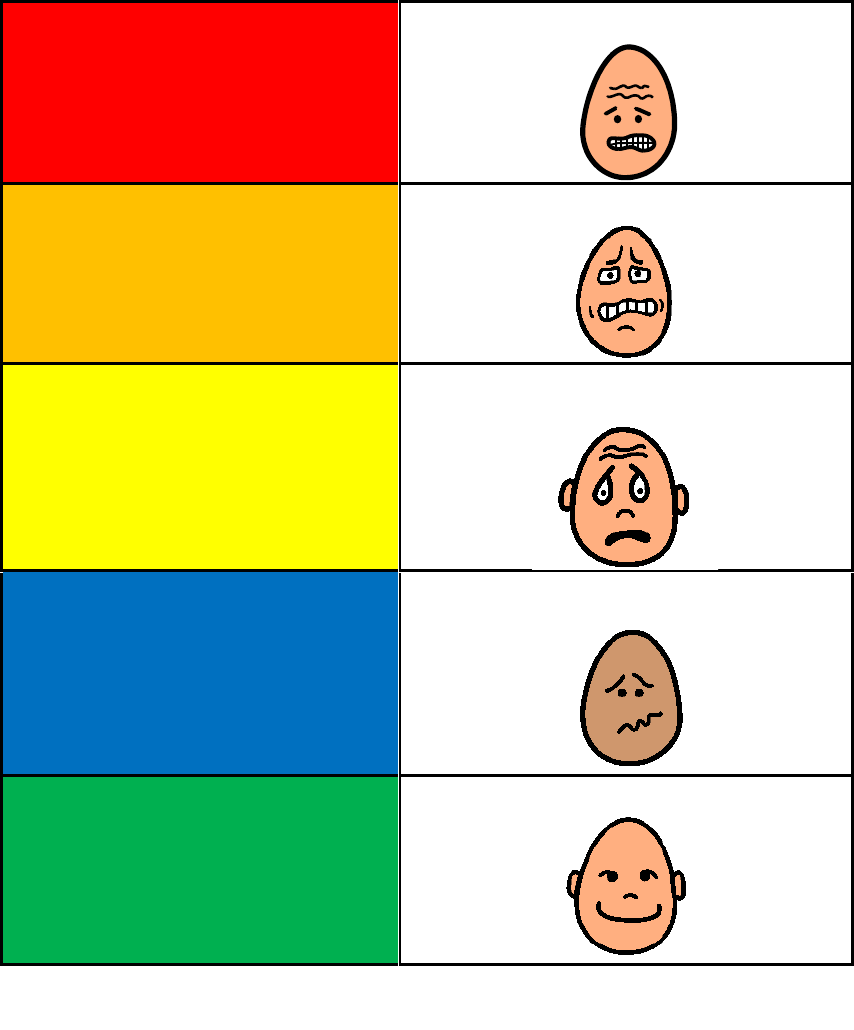
32
Anxiety Check In
Each number on the scale has a corresponding level of emotion e.g. 1 = happy, 2 =
a little worried, 3 = worried, 4 = really worried, 5 = extremely worried/anxious. Explain
these levels of emotion to your child so they understand and are able to
communicate their feelings to you using the numbers.
Adapted from Coffin, A. B., & Smith, S. M. (2009). The Incredible 5-Point Scale (Columbus)
5
Extremely worried/anxious
4
Really worried
3
Worried
2
A little worried
1
happy
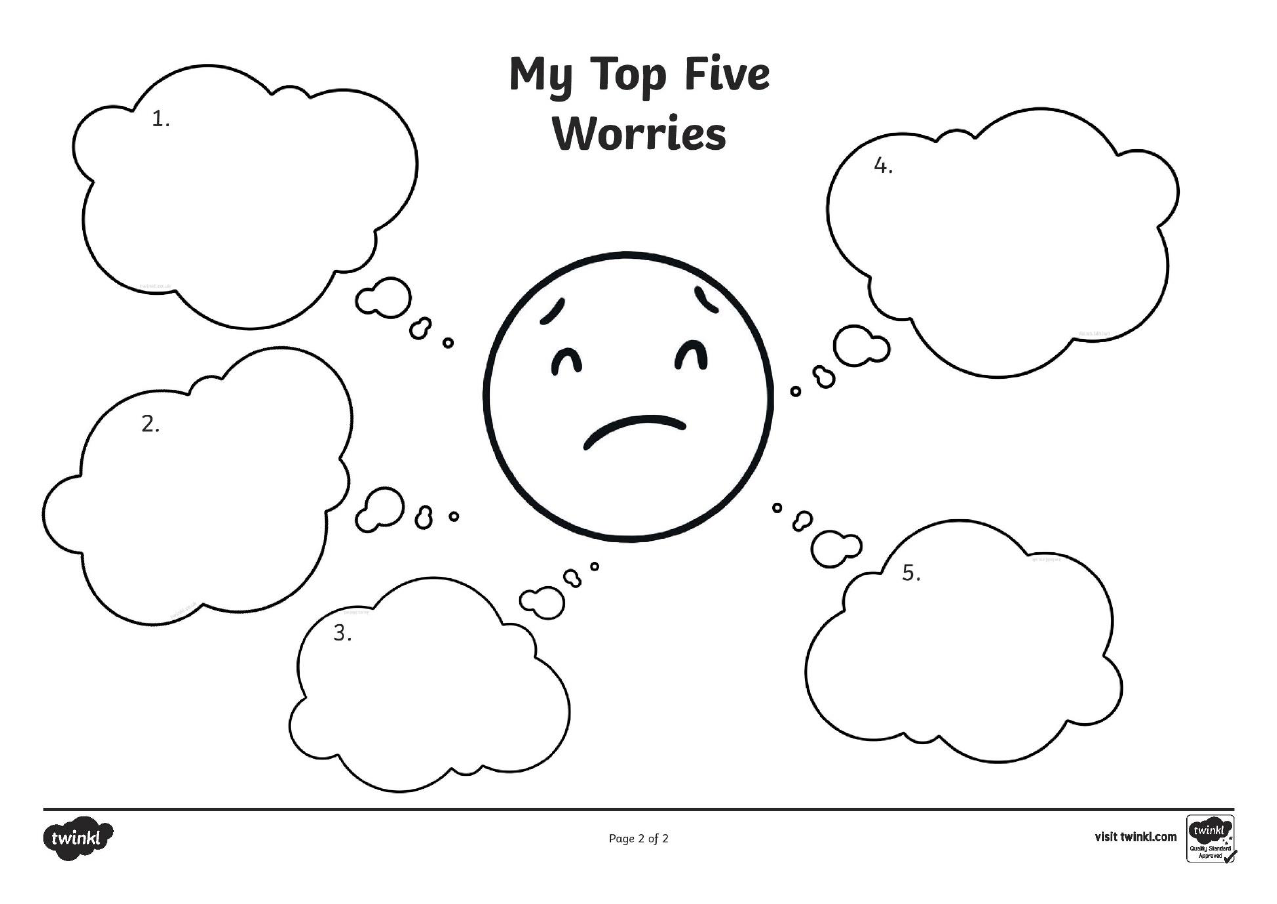
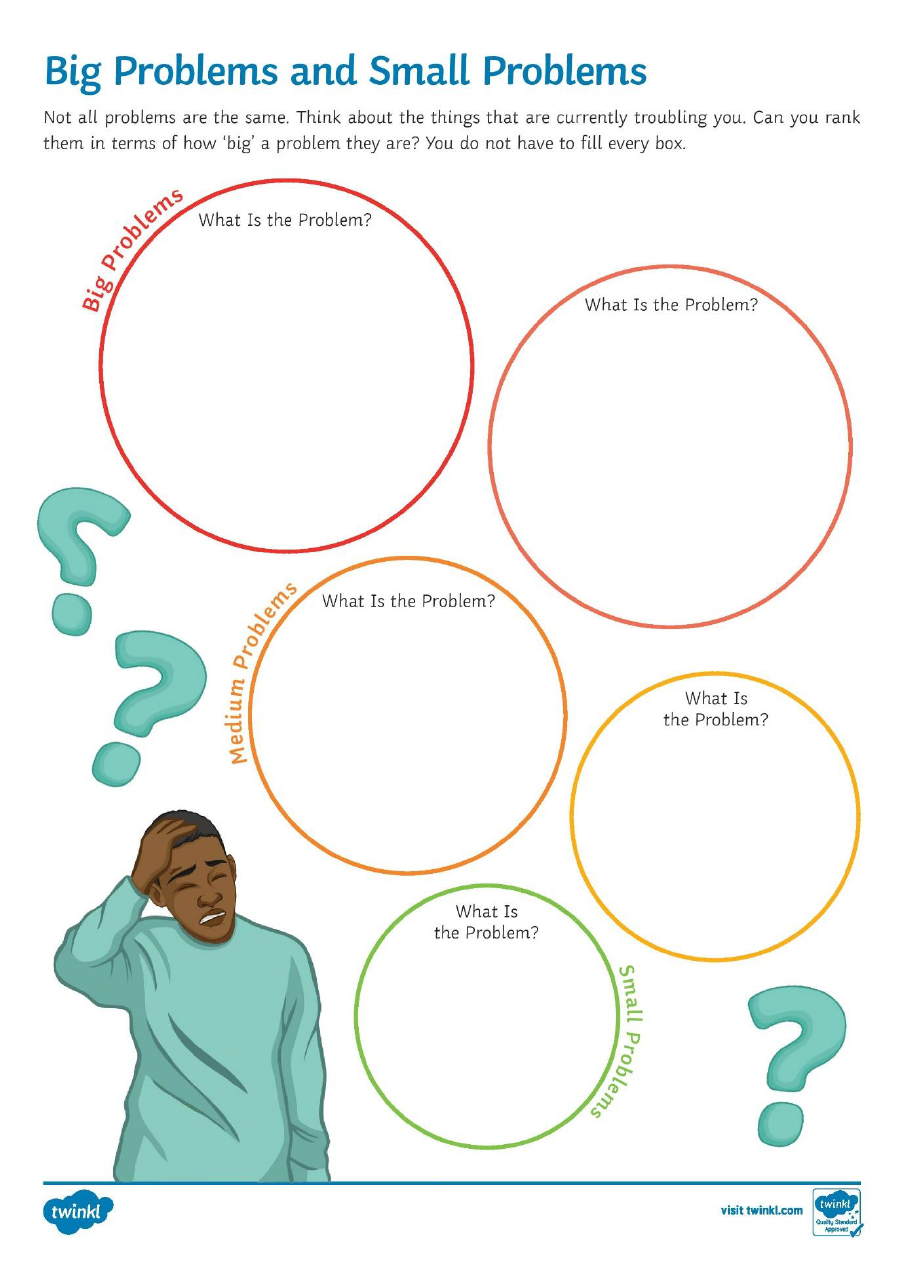
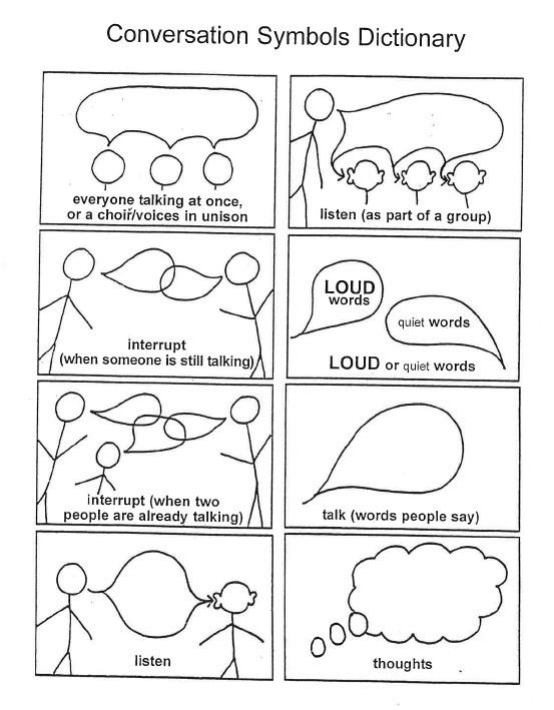
35
Comic Strip Conversations
Comic Strip conversations are simple, visual representations of conversation. They
show what is said in a conversations, how people might be feeling and what people’s
intentions might be. By seeing the different elements of a conversation presented
visually, some of the more abstract aspects of social communication are made
clearer and easier to understand.
Comic Strip Conversations use the following format
Adapted from Gray, C. (1994). Comic Strip Conversations.
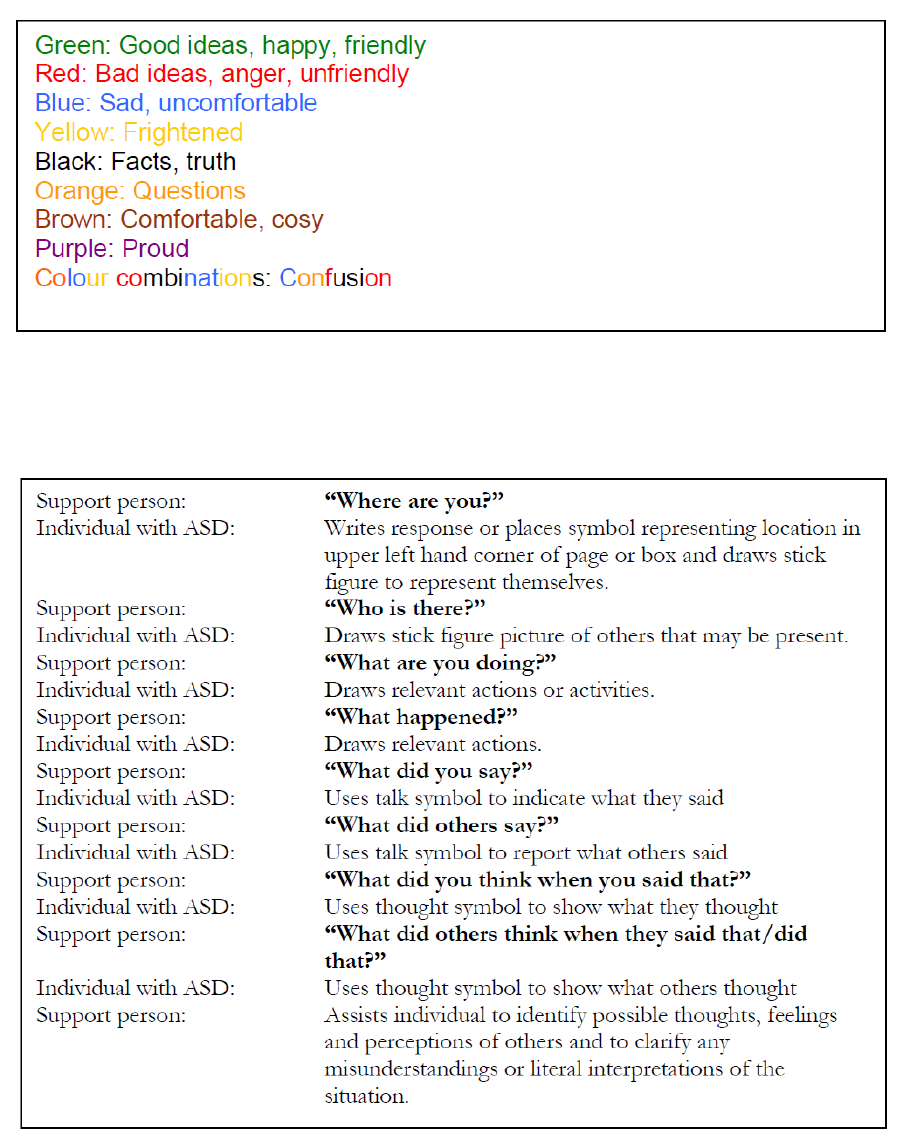
36
The following colours are used to represent feelings and ideas:
They are not meant to be used with every conversation but those which require a bit more
understanding. The child should take the lead role in the conversation. For example
Adapted from The National Autistic Society (2008)

37
Social Stories
Social Stories help improve social skills. Here are a couple of examples from which
you may like to devise your own. They model appropriate social interaction by
describing a situation with relevant social cues, other’s perspectives and suggested
appropriate responses.
Sometimes I get really frustrated and mad.
I may want to throw things, hit people, yell and cry.
When I act that way I can get in trouble and people won’t want to be my friend.
When I am frustrated, I need to take a deep breath, I can ask or a break, to take a
walk, get a drink of water or put my head down.
To tell people I am frustrated right now, I use my words. Soon I will feel better.
When Words Hurt – A Story for __________
Sometimes other people say and do things that make me mad.
Sometimes they give the wrong answer in class or break a rule, like cutting in line.
When people do these things, I get frustrated and before I think things through, I say
things that are very mean.
When I was little, I used to kick people when they said or did things that made me
mad, so I figured words were better than kicking.
Actually, words are better than kicking, but words can still be scary and hurtful.
When I say hurtful or mean things, other people may think I want to hurt them or that
I don’t like them.
When I say mean things, other people might decide not to be my friend any more.
My teacher can try to help by defining 4 words for me. I can write those words on my
scale and try to remember not to use them when I am mad.
I can also keep a journal of the things that make me mad. Sometimes writing it down
gives me just enough time to think about not using those 4 words.
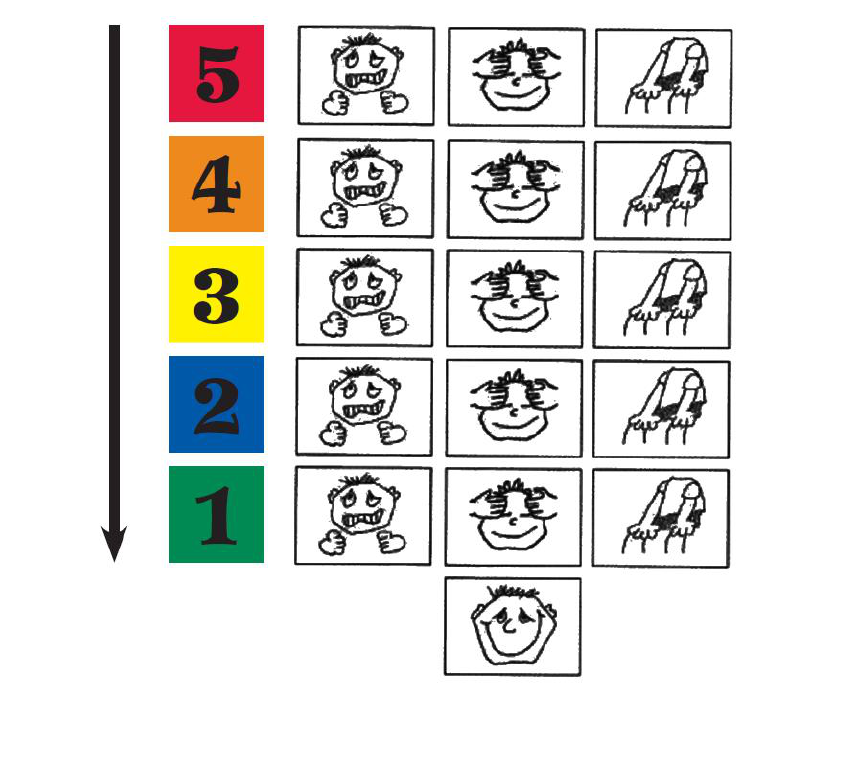
38
Tools
My Calming Sequence
Try this calming sequence. Does it feel good and calming? How
can you change it so that it works for you?
This calming sequence goes like this:
Squeeze your hands together.
Close your eyes and rub your head.
Rub your legs.
Repeat the sequence 5 times, bringing your stress down.
Adapted from Kuypers, L. (2011). The Zones of Regulation. Think Social Publishing.
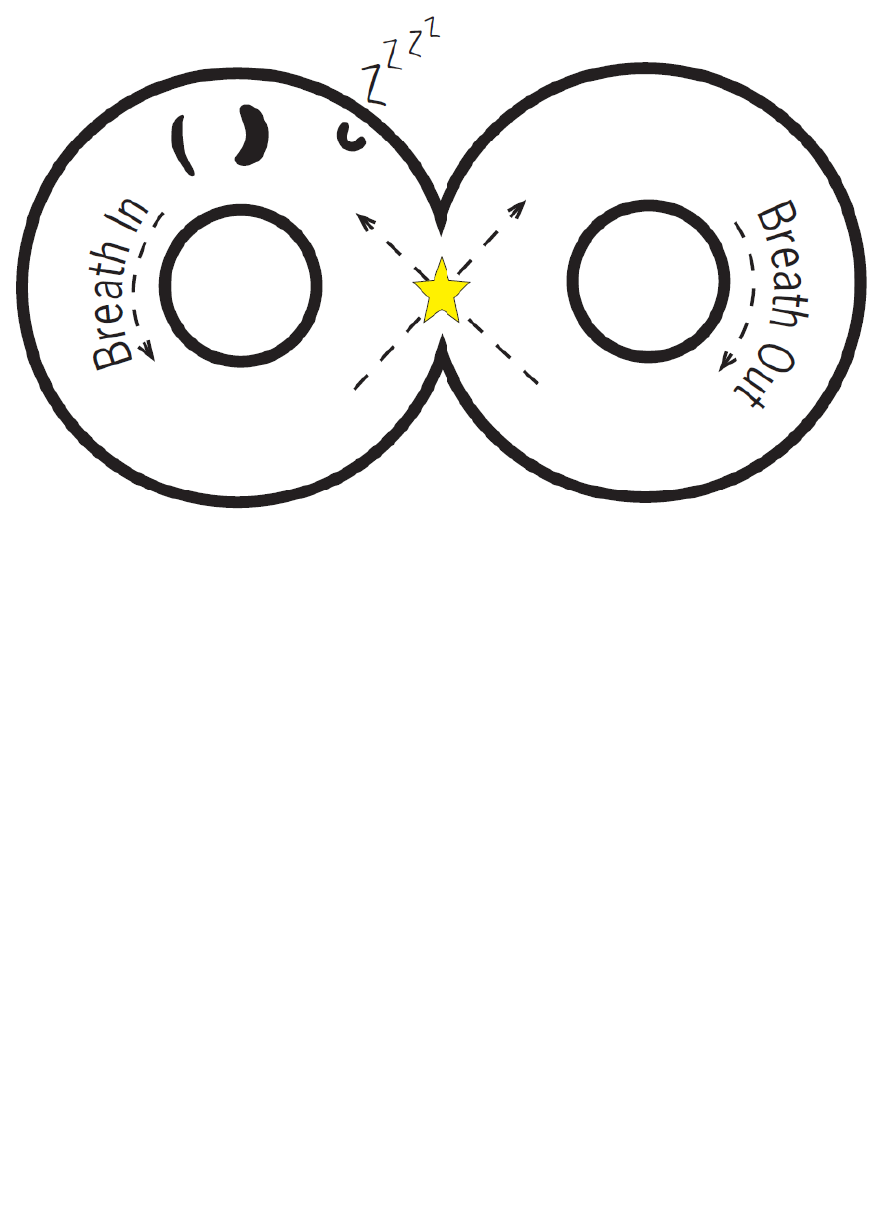
39
Lazy 8 Breathing
Trace the Lazy 8 with your finger starting at the star and taking
a deep breath in.
As you cross over to other side of the Lazy 8, slowly let your
breath out.
Continue breathing around the Lazy 8 until you have a calm
body and mind.
Adapted from Kuypers, L. (2011). The Zones of Regulation. Think Social Publishing.
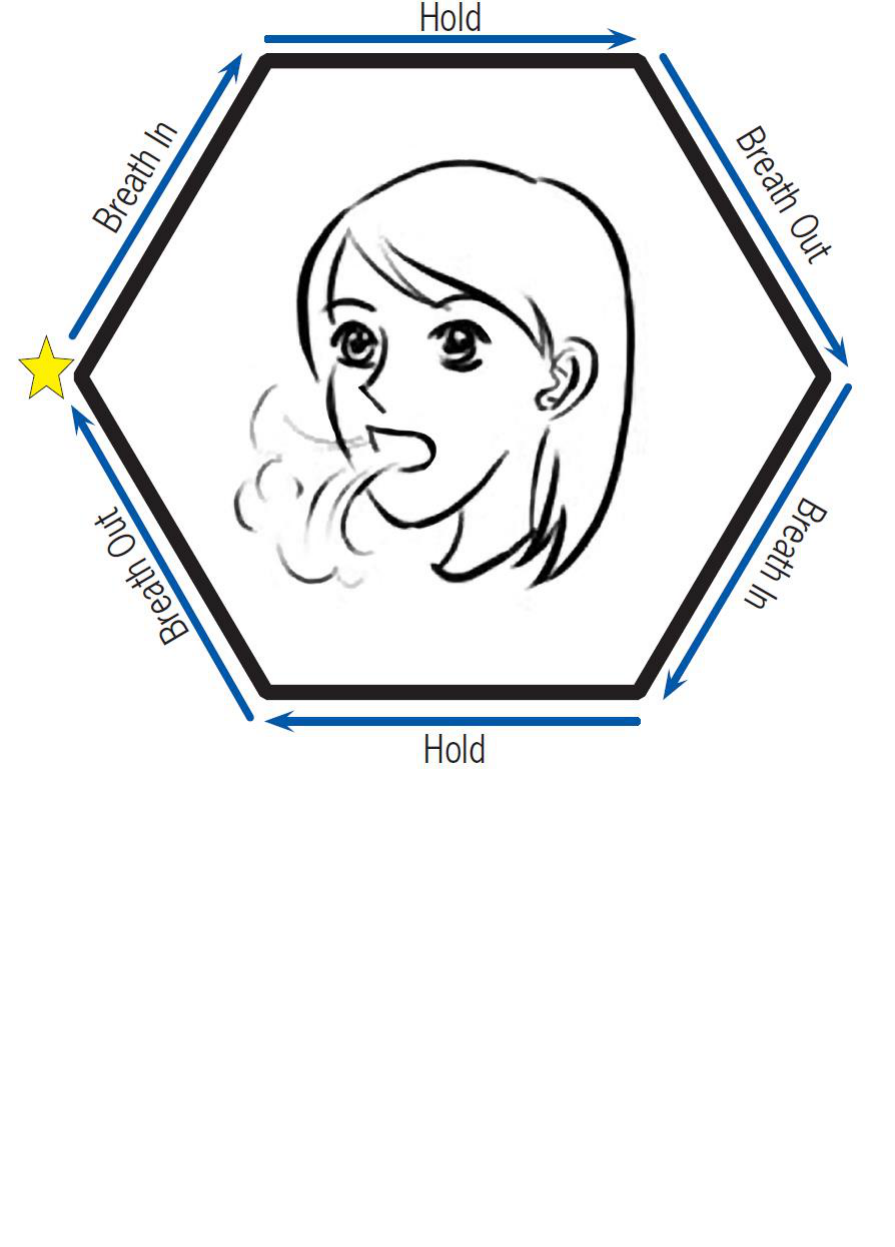
40
The 6 Sides of Breathing
Starting at the yellow star, trace with your finger around the six sides of
the hexagon, taking a deep breath in, feeling your shoulders rise as the
air fills you.
Trace over the next side as you hold your breath for a moment.
Slowly breathe out as you trace the third side of the hexagon.
Continue tracing around the bottom three sides of the hexagon as you
complete another deep breath.
Continue the 6 sides of breathing cycle until you feel calm and relaxed.
Adapted from Kuypers, L. (2011). The Zones of Regulation. Think Social Publishing

41
Anger Management Skill Cards
Please use these cards as prompts for your child when they need a distraction
Take 20 Deep Breaths
Draw Your Anger
Do 50 Jumping Jacks
Write About Your Anger
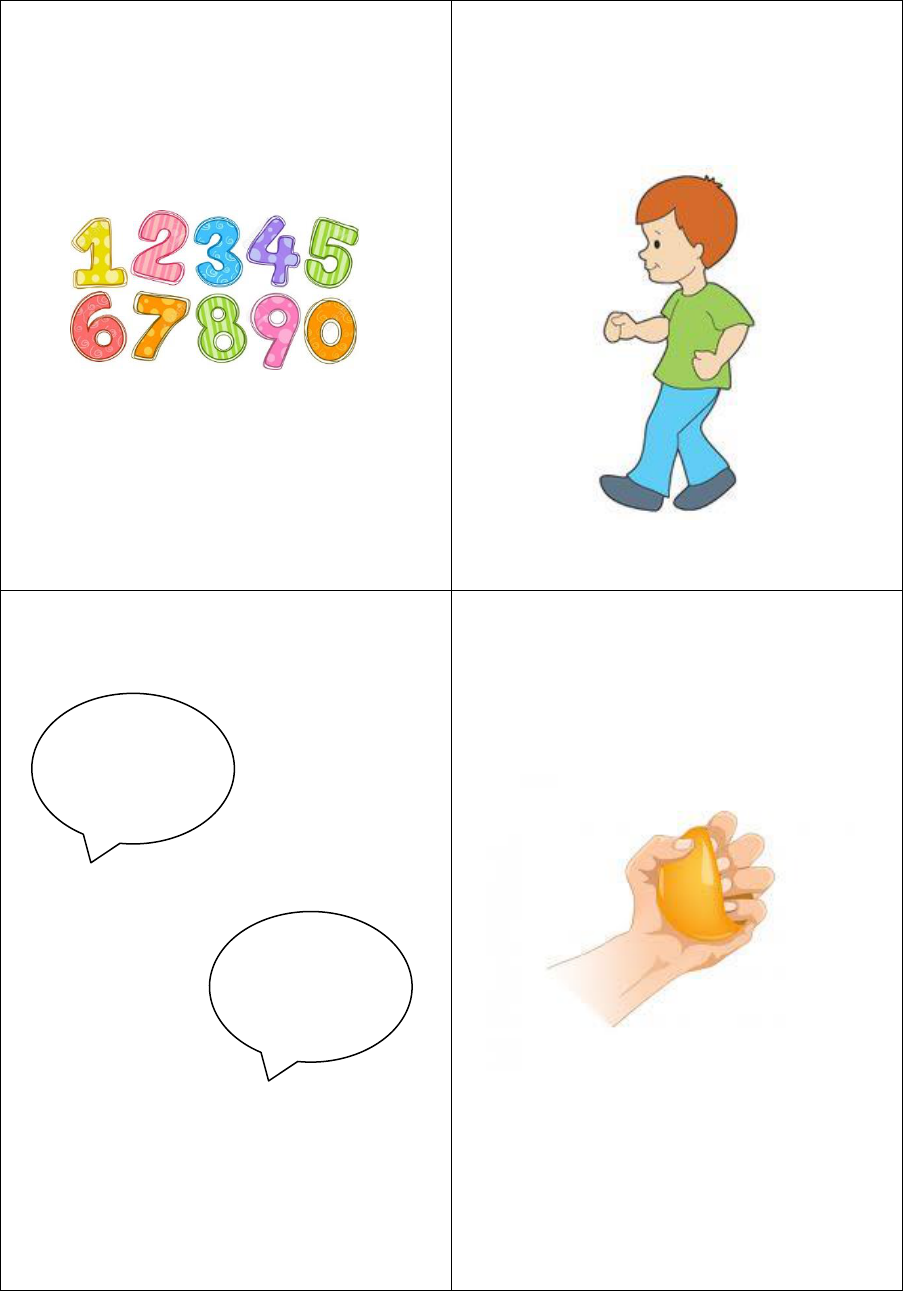
42
Count to 100
Walk Away
Talk to Someone about
Your Problem
Squeeze a Ball
I’m angry
Let me
help you.
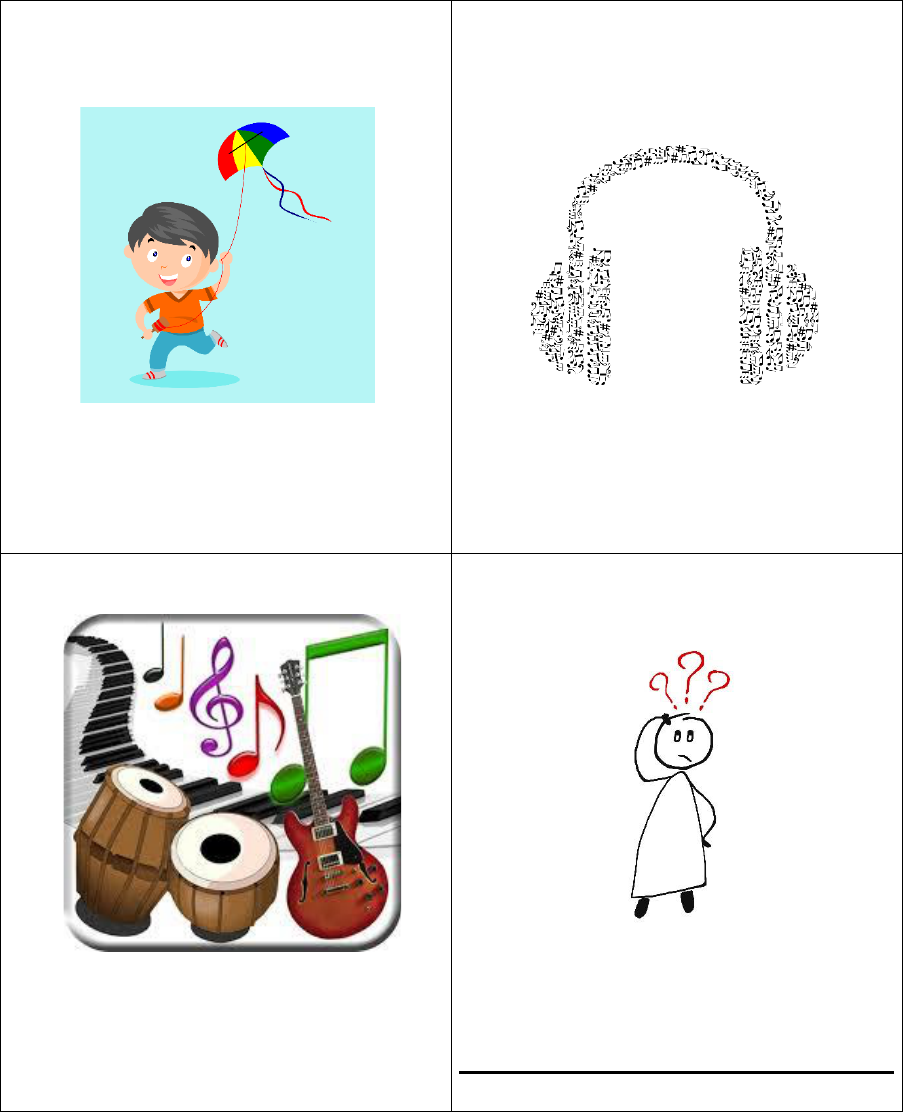
43
Play Outside
Listen to Music
Practice a Hobby
Your Own Idea:
Adapted from TherapistAid.com (2015)
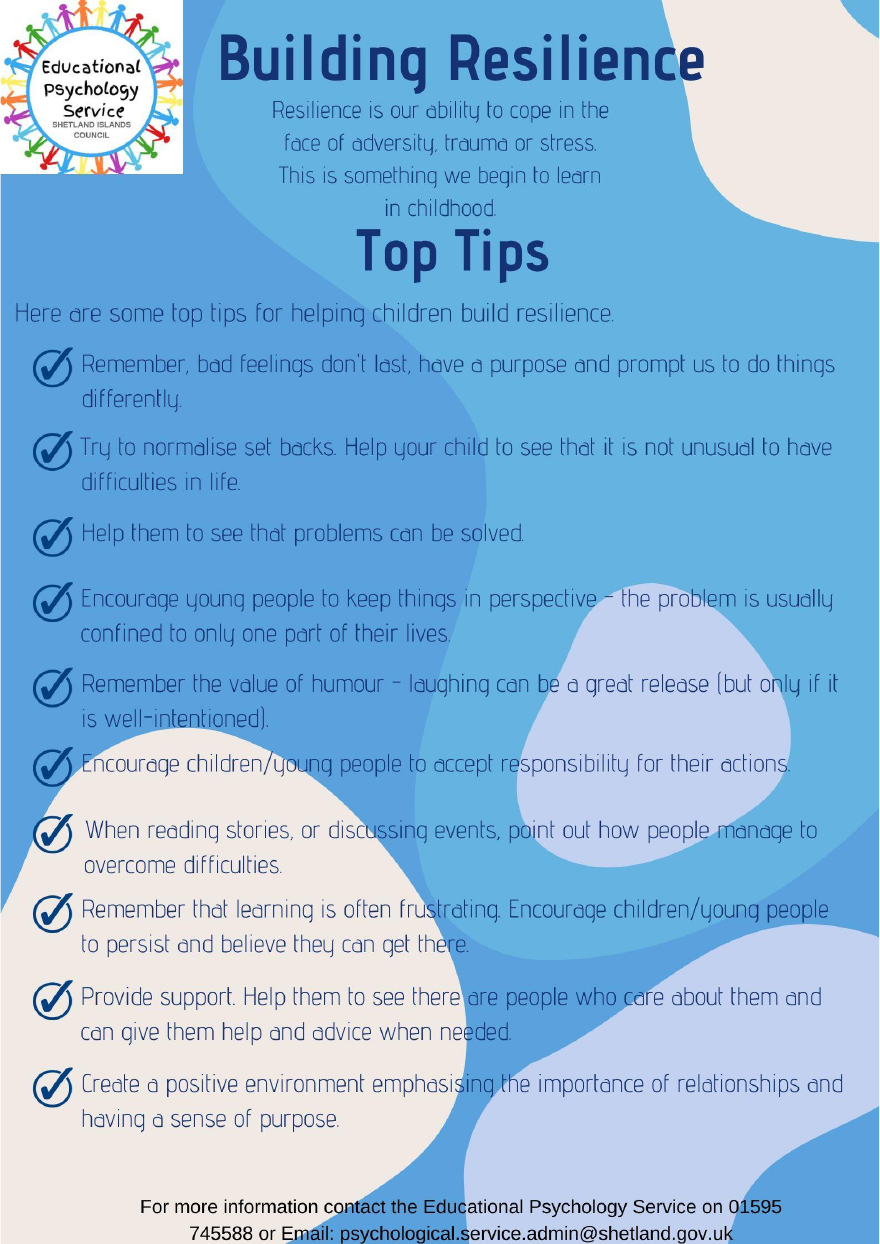
44
Appendix A
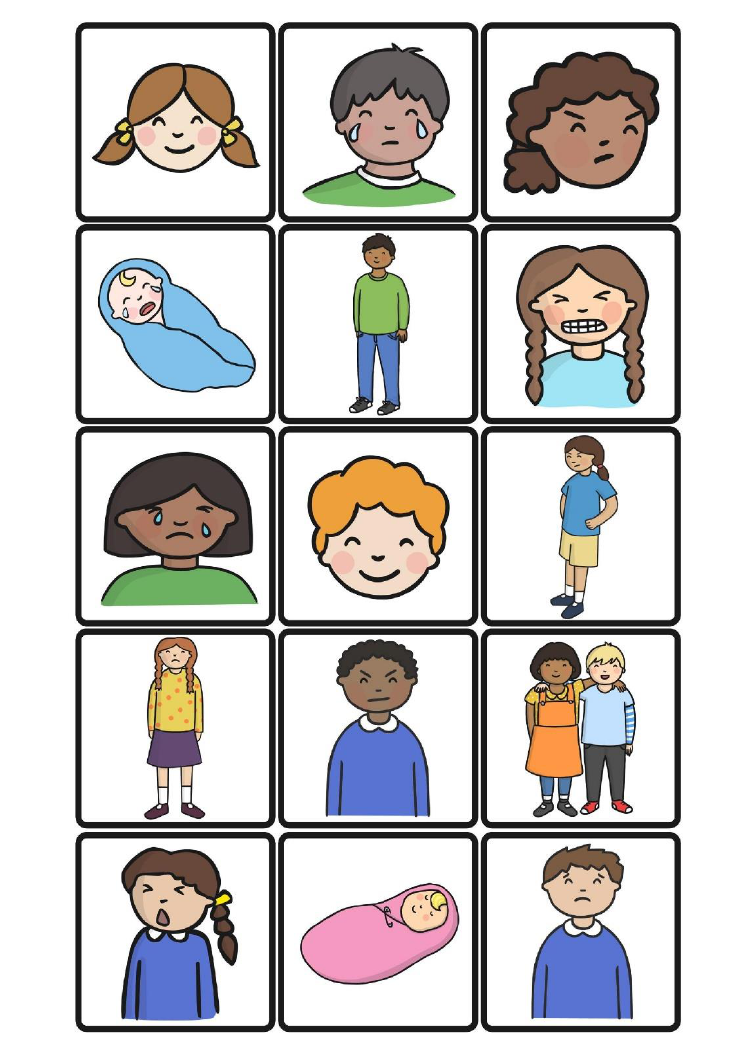
45
Appendix B
Identifying Emotions in Others
Cut out and place the different faces in the correct emotion circles on the following
pages.

46
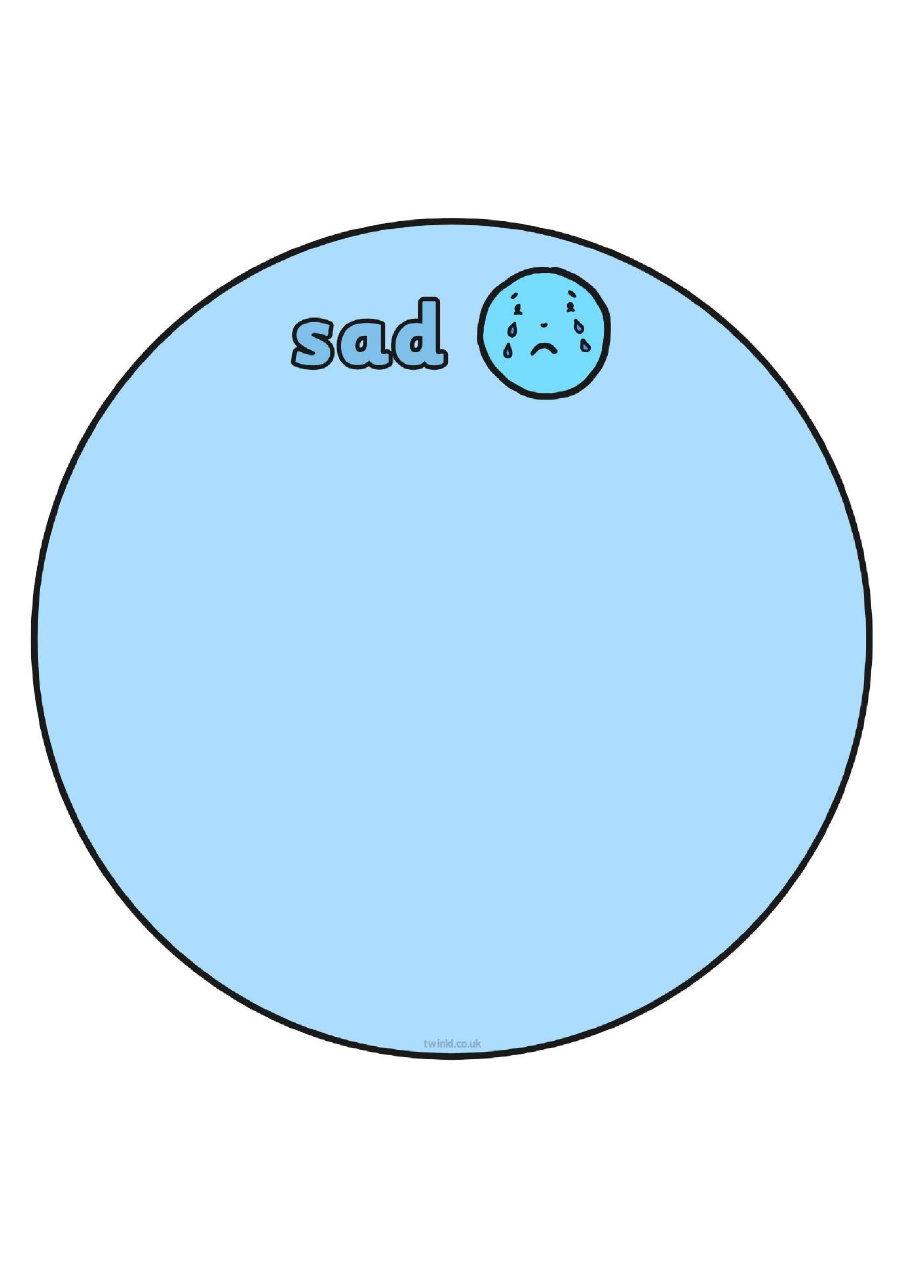
47
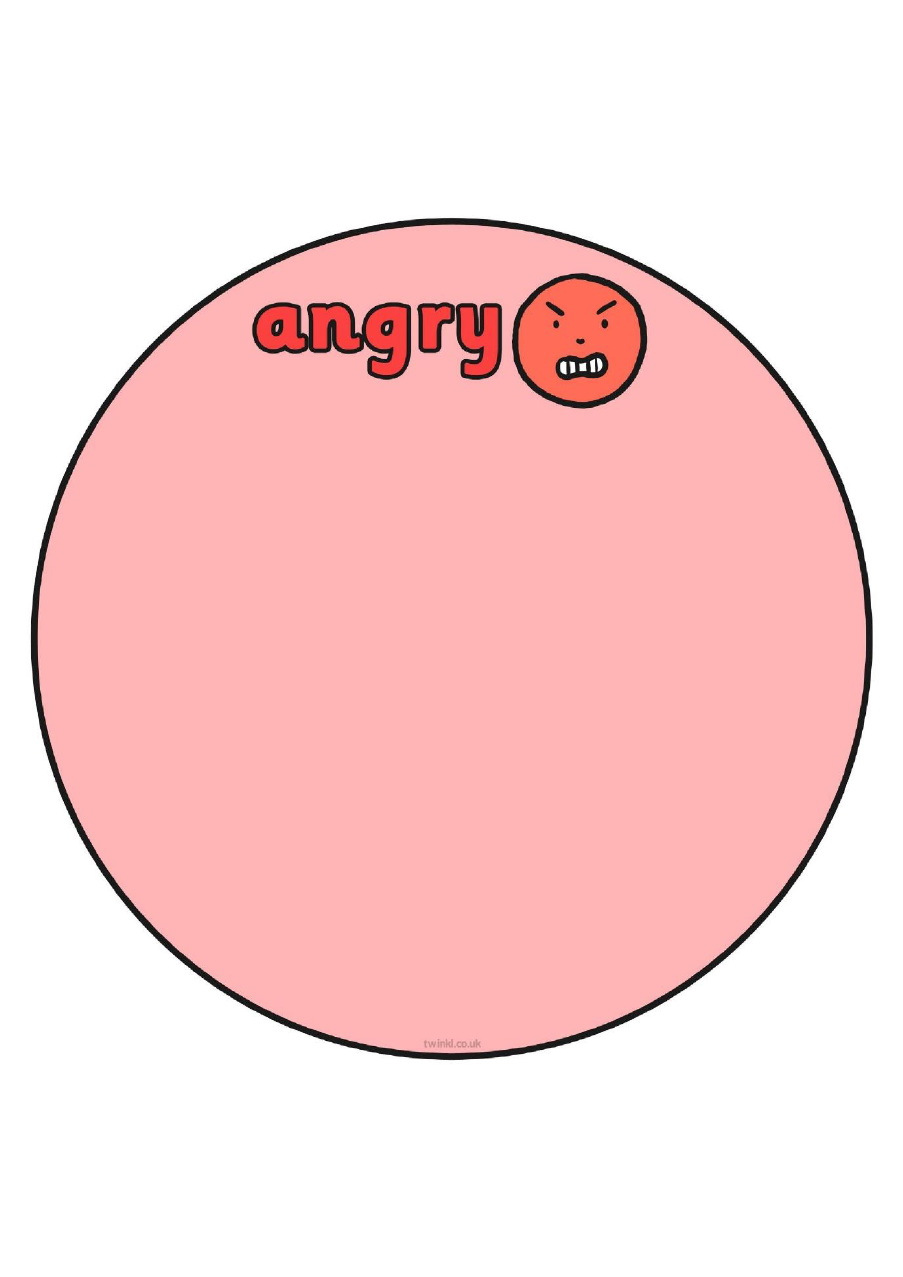
48
Adapted from www.twinkl.com

49
Appendix C
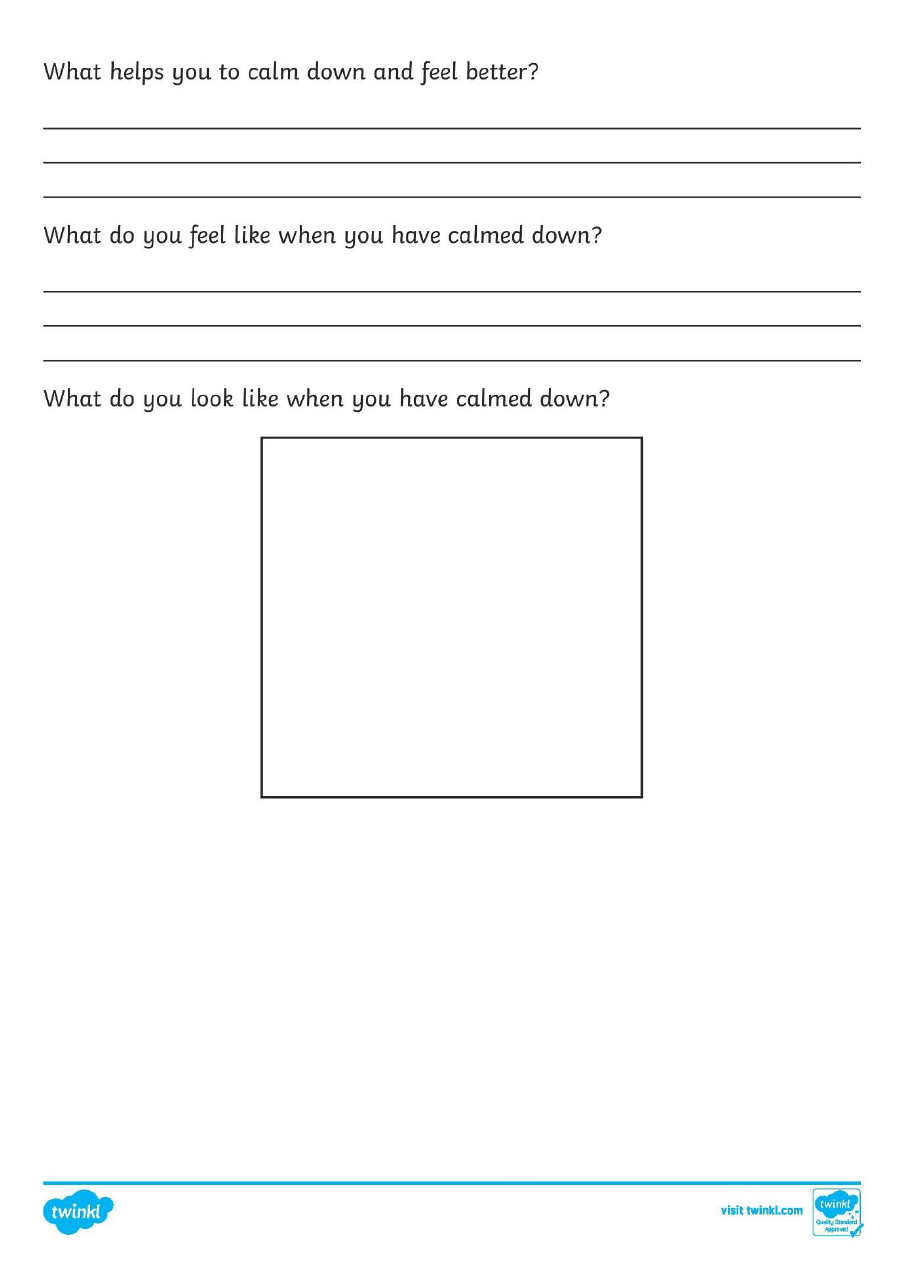
50
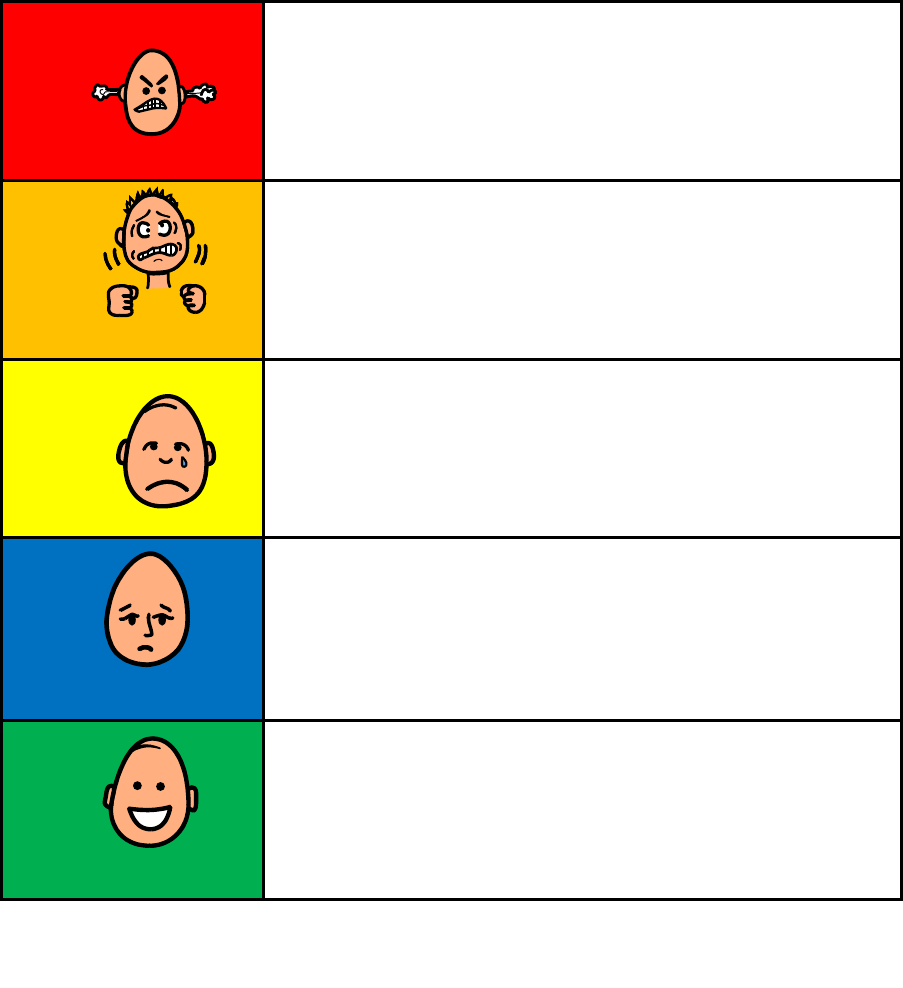
51
Appendix D
The Stress Scale
The stress scale allows children to identify what triggers them. You may need to
support children with some examples e.g. I could lose control when the Xbox stops
working.
Adapted from Coffin, A. B., & Smith, S. M. (2009). The Incredible 5-Point Scale (Columbus)
5
I could lose control
4
Can really upset me
3
Makes me nervous
2
Bugs me
1
Never bothers me
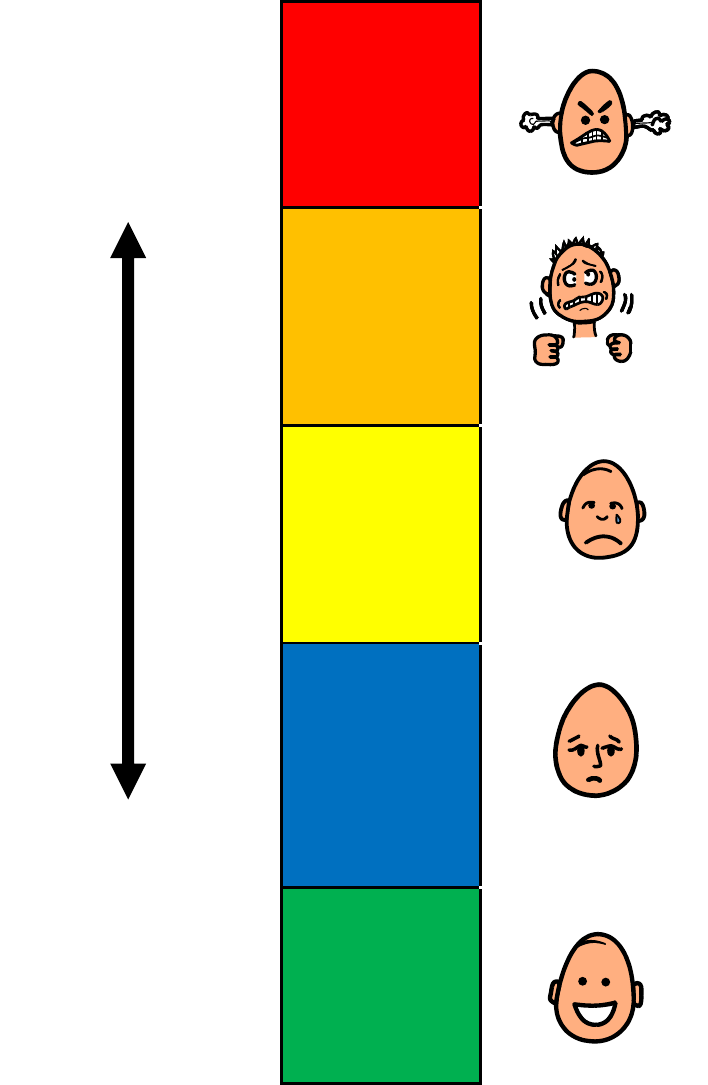
52
Appendix E
The High - Low Scale
How might you look from the high to the low end of the scale? How might this
make others around you feel and how might they act towards you? Draw your
own faces for each colour on the next page…
High
5
That person is scary!
4
I’m not going near
them.
3
They look like they
want to be left alone
2
I wonder if they are
ok?
Low
1
I like to sit near you.
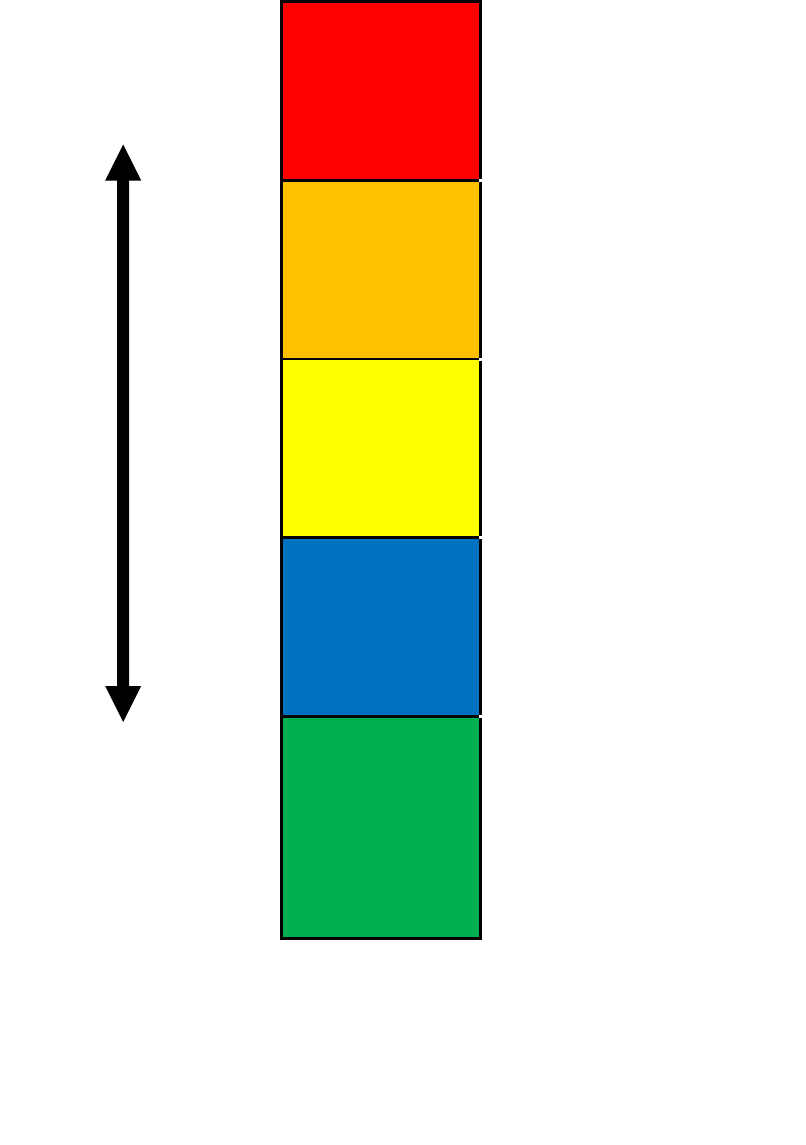
53
Your Turn
Adapted from Coffin, A. B., & Smith, S. M. (2009). The Incredible 5-Point Scale (Columbus)
High
5
That person is scary!
4
3
2
Low
1
I like to sit near you.

54
Appendix F
Cut Out and Keep Scales
Please cut out and stick the coloured scales around your home to help prompt your
child. You may wish to stick one on the fridge, in their bedroom etc. You could also
have one laminated to use when out and about.
5
5
4
4
3
3
2
2
1
1
5
5
4
4
3
3
2
2
1
1
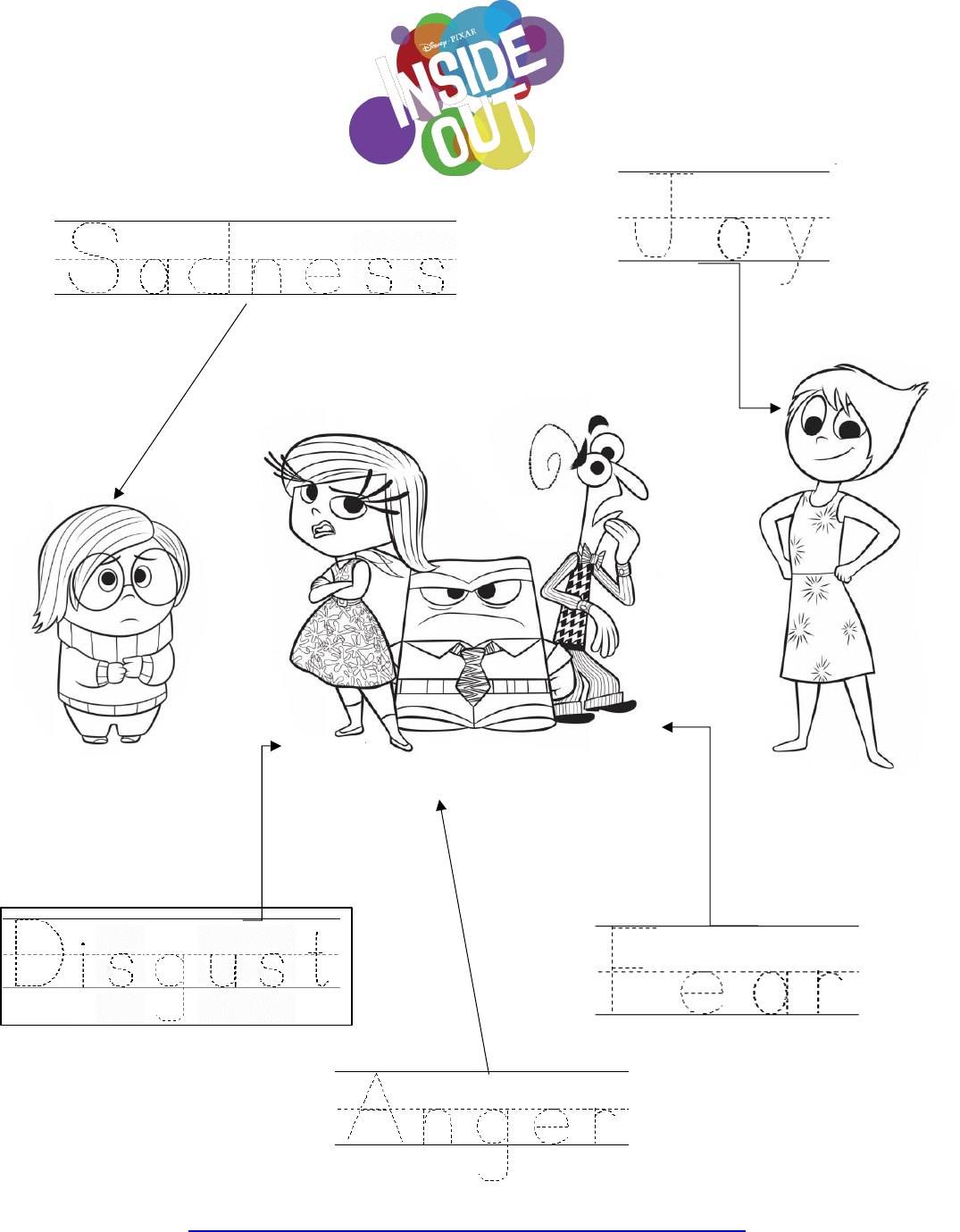
Appendix H
Adapted from https://en.islcollective.com/english-esl-worksheets/search/Inside+Out
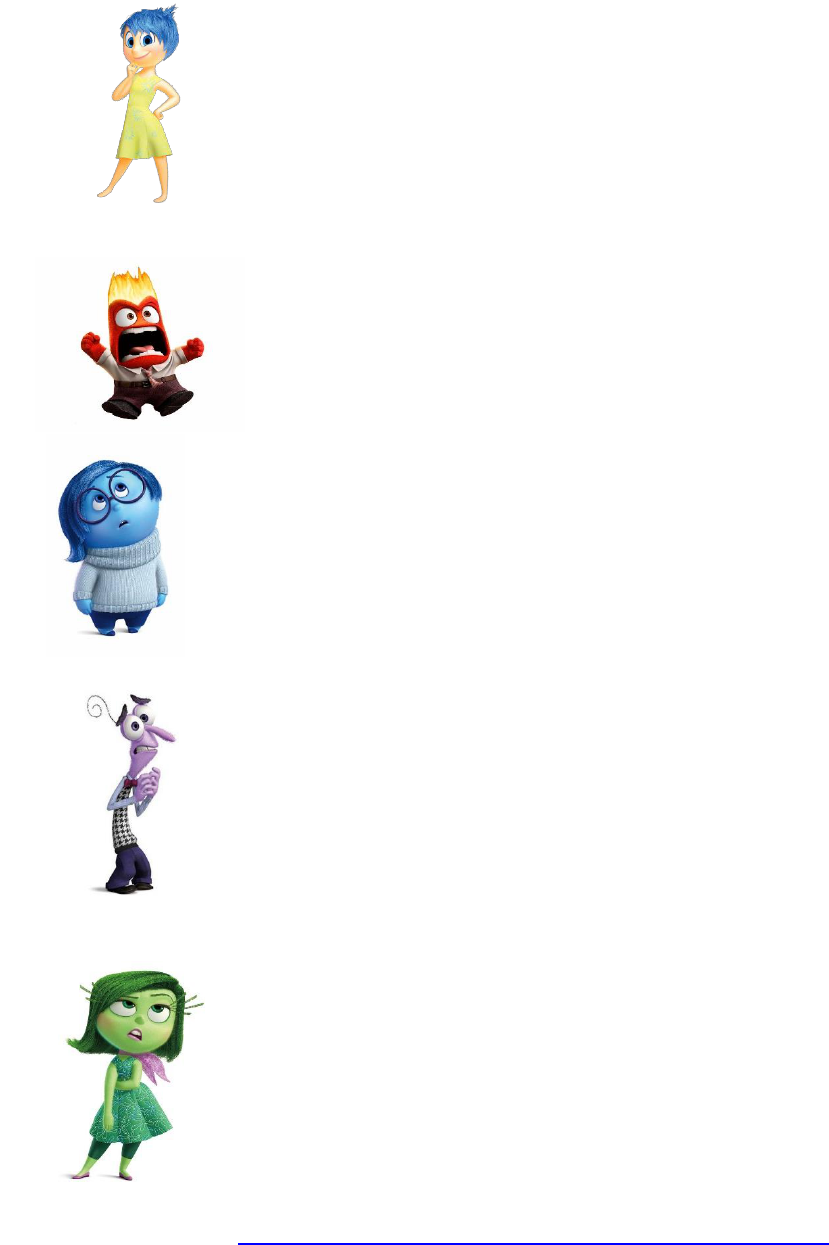
57
Appendix I
Inside Out Feelings and Calm Down Worksheet
I might feel: To calm down, I can:
________________ ____________________
________________ ____________________
I might feel: To calm down, I can:
_________________ ____________________
_________________ ____________________
I might feel: To calm down, I can:
_________________ ____________________
_________________ ____________________
I might feel: To calm down, I can:
_________________ ____________________
_________________ ____________________
I might feel: To calm down, I can:
________________ ___________________
________________ ___________________
Adapted from https://crayonsandcompliance.wordpress.com/tag/inside-out/
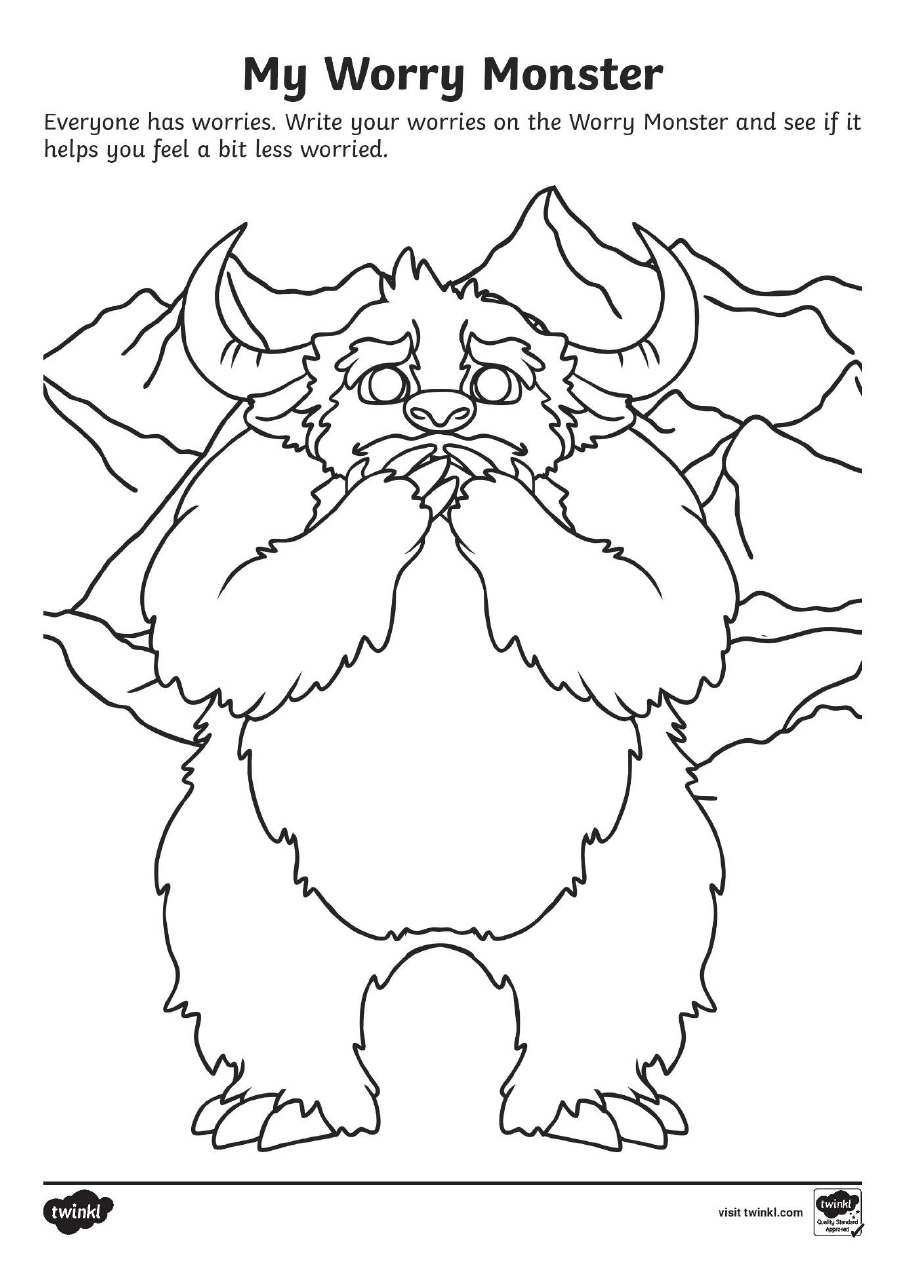
58
Appendix J
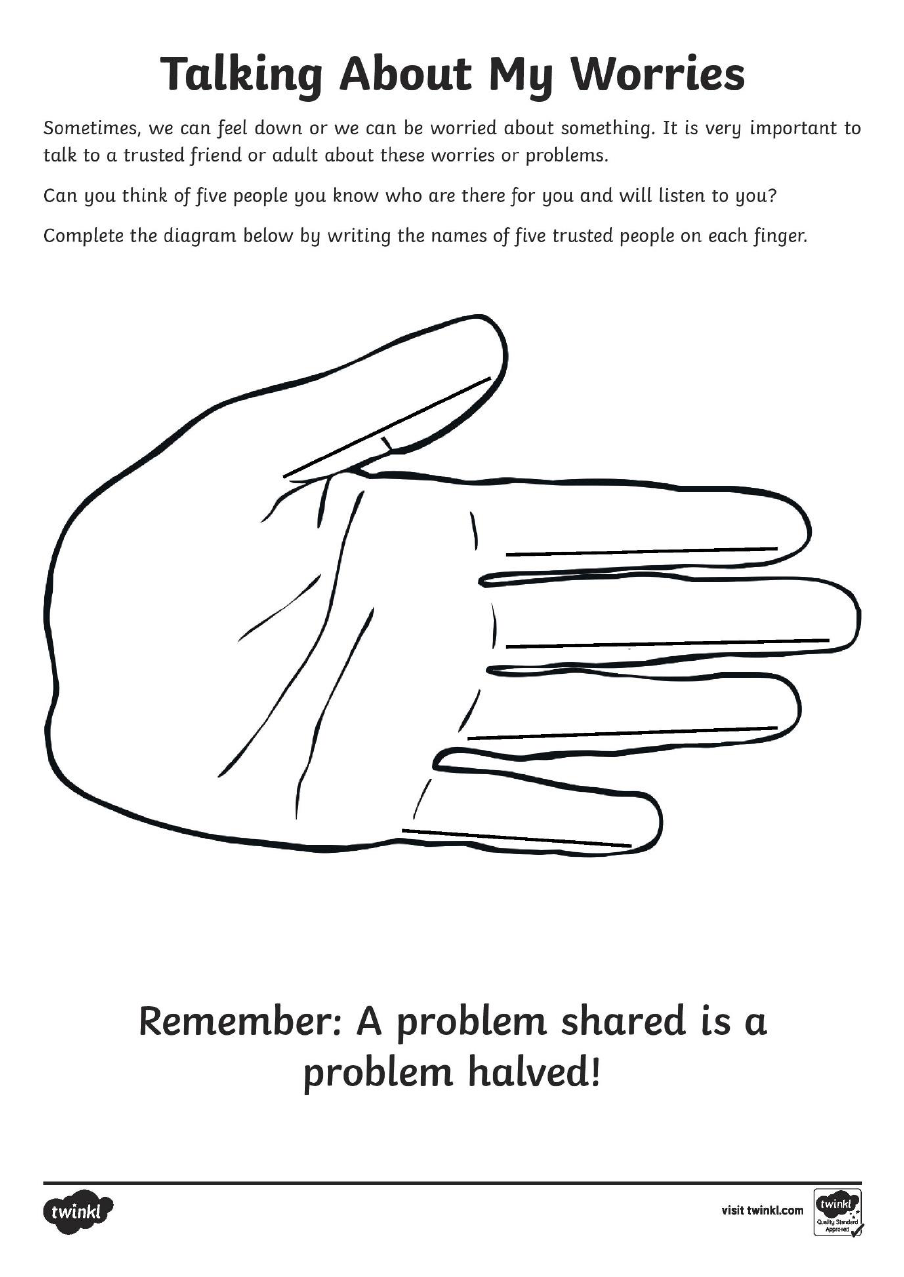
59
Appendix K

Useful Links
Books
My Hidden Chimp by Professor Steve Peters, explains the neuroscience of the brain
to children in a straightforward way and introduces the use of 10 specific habits in
order to manage our emotions and behaviour.
The Big Life Journal is a useful book to use with your child to help them develop a
growth and resilient mindset so they feel like they can face life’s challenges with
confidence. There are 2 journals to choose from, one for younger children (aged 7-
10) Big Life Journal for children and one for teens (aged 11+) Big Life Journal teens
Starving the Anxiety Gremlin: A Cognitive Behavioural Therapy Workbook on Anxiety
Management for Young People by Kate Collins-Donnelly, helps young people
understand different types of anxiety and how to manage them using a cognitive
behavioural therapy approach. The book can be used by those aged 10+ on their
own or with a parent.
The Incredible 5 Point Scale: The Significantly Improved and Expanded Second
Edition by Kari Dunn Buron and Mitzi Cutis has been adapted to form some of this
toolkit.
The Zones of Regulation is a curriculum developed by Occupational Therapists to help
children self-regulate.
What to do When You Worry too Much: A Kid’s Guide to Overcoming Anxiety by
Dawn Heubner, is a book designed to help 6-12 year olds through cognitive
behavioural therapy techniques in relation to anxiety and worry.
https://www.amazon.co.uk/What-When-Temper-Flares-What/dp/1433801345 A Kid’s
Guide to Overcoming Anger by Dawn Heubner, is a book designed to help 6-12 year
olds manage their anger.
Links
For some fun games and activities around self-regulation, that can be done at home
please look at:
https://www.theottoolbox.com/zones-of-regulation-activities/
To help your child keep calm please visit:
https://childmind.org/article/how-to-help-children-calm-down
https://www.bbc.co.uk/cbeebies/joinin/seven-techniques-for-helping-kids-keep-calm
https://bbc.co.uk/cbeebies/joinin/dualwa-anxiety-in-primary-school

61
https://www.bbc.co.uk/cbeebies/joinin/help-children-cope-with-emotions
The following links contain useful information on mindfulness and further activities.
www.blissfulkids.com
www.educationsvoice.wordpress.com
www.mentalhealth.org.uk/publications/be-mindful-report
www.youthmindfulness.org
Video Clips
The following video clips talk children through calming meditations. You may find it
helpful to do these alongside your child as a fun activity.
Kindness meditation is a 6 minute clip that children can listen to help them relax and
learn to be kind to themselves.
Balloon meditation is a 5 and half minute clip to help us gain control of our stressful
energy when it becomes too hard to handle.
Breathing meditation is a 9 and half minute clip to help children explore their breath
in order to remain calm and relaxed.
Apps
The following are links to Apps that may be useful when implementing mindfulness
based approaches within in the home.
www.calm.com
www.headspace.com
www.insighttimer.com
www.stopbreathethink.com
www.serenitymeditations.co.uk

62
References
Buron, K. D. and Curtis, M (2012) The Incredible 5 Point Scale. AAPC Publishing.
Coffin, A. B., & Smith, S. M. (2009). The Incredible 5-Point Scale. Columbus.
Kuypers, L (2011) The Zones of Regulation. Think Social Publishing
